Paul van Yperen's Blog, page 6
August 8, 2025
Shirley Jones
American actress and singer Shirley Jones (1934) had her breakthrough in her first film, the great musical Oklahoma! (1955) as Laurey, the farm girl in love with cowboy Gordon MacRae. The following year, she starred in another classic musical, Carousel (1956). But by this time, musicals were a dying art. She changed her peachy-cream image with her role as a vengeful prostitute in the drama Elmer Gantry (1960), for which she won the Oscar for Supporting Actress. A decade later, she returned on television as a widowed mother of five children in the popular series The Partridge Family (1970-1974) opposite her real-life stepson, teen idol David Cassidy.

Big vintage card.

British postcard in the Picturegoer Series, London, no. D 818. Photo: 20th Century Fox. Gordon MacRae and Shirley Jones in Carousel (1956).
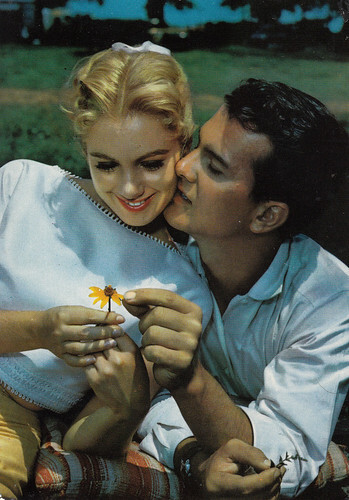
Spanish postcard by C y A, no. 87. Shirley Jones and Pat Boone in April Love (Henry Levin, 1957). Collection: Marlene Pilaete.
The dying art of the film musical
Shirley Jones was born Shirley Mae Jones in 1934 in Charleroi, Pennsylvania. Her Methodist parents were Marjorie (née Williams), and Paul Jones, owner of the Jones Brewing Company. She was named after child star Shirley Temple . Jones started singing at the age of six in the Methodist Church choir. She started formal training at the age of 12 and would dream of singing with her idol, Gordon MacRae .
Jones won the Miss Pittsburgh contest in 1952. Upon graduating from high school, Shirley went to New York to audition for John Fearnley, casting director for Rodgers and Hammerstein and their various musicals. Fearnley was so impressed, he ran across the street to fetch Richard Rodgers, who was rehearsing with an orchestra for an upcoming musical. Rodgers then called Oscar Hammerstein at home. The two saw great potential in Jones. She became the first and only singer to be put under personal contract with the songwriters. Shirley's Broadway debut was a minor role as a nurse in the musical 'South Pacific'.
Within a year, she would be in Hollywood to appear in her first film, the musical Oklahoma! (Fred Zinnemann, 1955) as Laurey, the farm girl in love with the cowboy Gordon MacRae . Oklahoma! (1955) would be filmed in CinemaScope and Todd-AO wide-screen and would take a year to shoot.
After that, Shirley returned to Broadway for the stage production of 'Oklahoma!' before returning to Hollywood for Carousel (Henry King, 1956), again with Gordon MacRae. Other film musicals quickly followed, April Love (Henry Levin, 1957) with teen idol Pat Boone , and Never Steal Anything Small (Charles Lederer, 1959) starring James Cagney .
But by this time, musicals were a dying art, and she would have a few lean years. In Great Britain, she appeared in the mediocre comedy Bobbikins (Robert Day, 1959), starring Max Bygraves and a talking baby. She would work on television in programs like Playhouse 90 (1956) and The United States Steel Hour (1957). Both were anthology series which brought hour-long dramas to television.
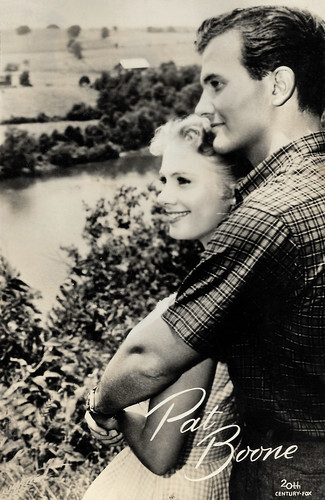
Dutch postcard by Uitg. Takken, Utrecht, no. 3344. Photo: 20th Century Fox. Pat Boone and Shirley Jones in April Love (Henry Levin, 1957).
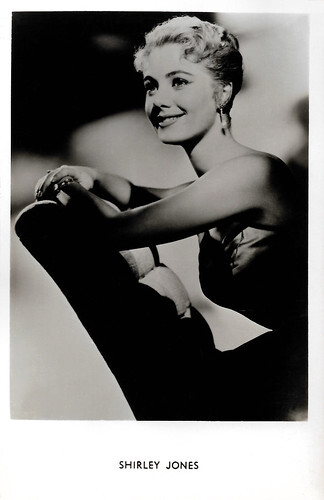
Vintage postcard, no. 5210.
A darker role to change her peachy-cream image
With a screen image comparable to Peaches and Cream, Shirley Jones wanted a darker role to change her image. In 1960, Richard Brooks cast her as the vengeful prostitute Lulu Bains in the dramatic film Elmer Gantry (Richard Brooks, 1960). With a brilliant performance against an equally brilliant Burt Lancaster , Shirley won the Oscar for Best Supporting Actress. In 1961, she was also nominated for a Golden Globe for Elmer Gantry. In total she was nominated four times for a Golden Globe in 1963 (starring in the film musical The Music Man), 1971 and 1972 (both times for her lead role in the musical sitcom The Partridge Family).
But the public wanted the good Shirley, so she was cast as Marty Purcell in the Western Two Rode Together (John Ford, 1961) and as Marion, the librarian, in the successful musical The Music Man (Morton DaCosta, 1962), starring Robert Preston and the young Ron Howard. Preston had played the role on Broadway, and his performance, along with Shirley was magic.
Shirley would again work with little Ron Howard in The Courtship of Eddie's Father (Vincente Minnelli, 1963) starring Glenn Ford . With an uncharacteristically brunette hairstyle, Jones played the role of a woman who falls in love with Tony Randall's lion-owning professor in Fluffy (Earl Bellamy, 1965). But the films changed in the 1960s, and Shirley's image did not fit. Her film career stopped in 1965, but there were always nightclubs and later television. In 1970, she was nominated for a Primetime Emmy Award for her lead role in the TV drama Silent Night, Lonely Night. Decades later, in 2006, she was nominated again for her supporting role in the television film Hidden Places (Yelena Lanskaya, 2006) and in 2010 for her one-off guest role in the drama series The Cleaner).
A new generation discovered her as Shirley Partridge in the television series The Partridge Family (1970-1974), a musical sitcom based loosely on the real-life musical family The Cowsills. The series focused on a young widowed mother whose five children form a pop-rock group after the entire family painted its signature bus to travel. The show also spawned a number of albums and singles by The Partridge Family, performed by David Cassidy and Shirley Jones. That same year, 'I Think I Love You' reached number one on the Billboard Hot 100 music chart. While the success of the show would do more for her stepson, 20-year-old teen idol David Cassidy, it would keep her name and face in the public view for the four years that the series ran. The show still plays in reruns. After the show ended, Shirley Jones spent the rest of the 1970s in the land of television movies. The television movie The Lives of Jenny Dolan (Jerry Jameson, 1975) was made as a pilot for a series that was not picked up. In 1979, Shirley appeared in a comedy show called Shirley (1979-1980), but the show lasted only one season.
Shirley Jones would appear infrequently in the 1980s, and in videos extolling fitness and beauty at the end of the decade. Her later films include the action comedy Tank (Marvin J. Chomsky, 1984) with James Garner , the parody Shriek If You Know What I Did Last Friday the Thirteenth (John Blanchard, 2000) and the comedy Grandma's Boy (Nicholaus Goossen, 2006). Her first marriage to actor Jack Cassidy lasted from 1956 to 1975. With him, she had three sons, Shaun (1958), Patrick (1962), and Ryan Cassidy (1966). Jones married again in 1977, to actor Marty Ingels. She published a book about her life with Ingels in 1990, titled 'Shirley and Marty: An Unlikely Romance'.
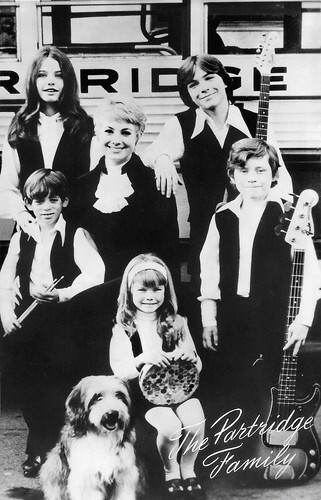
Dutch postcard by Muziek Parade, Bussum, no. AX 2792. Susan Dey, David Cassidy, Shirley Jones, Jeremy Gelbwaks, Suzanne Crough and Danny Bonaduce in the TV series The Partridge Family (1971-1974).
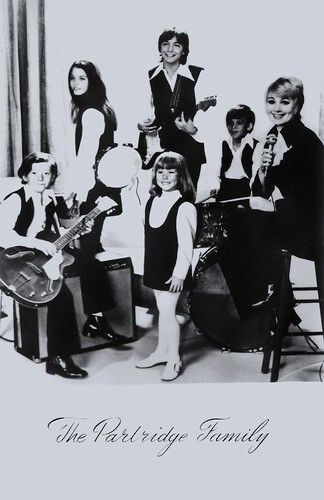
Dutch postcard by Muziek Parade, Bussum, no. AX 7265. Danny Bonaduce, Susan Dey, David Cassidy, Suzanne Crough, Jeremy Gelbwaks and Shirley Jones in the TV series The Partridge Family (1971-1974).

Dutch postcard by Muziek Parade, Bussum, no. 7294. David Cassidy, Shirley Jones, Susan Dey, Brian Forster, Suzanne Crough and Danny Bonaduce in the TV series The Partridge Family (1971-1974).
Sources: (IMDb), Wikipedia (Dutch and English) and .

Big vintage card.

British postcard in the Picturegoer Series, London, no. D 818. Photo: 20th Century Fox. Gordon MacRae and Shirley Jones in Carousel (1956).

Spanish postcard by C y A, no. 87. Shirley Jones and Pat Boone in April Love (Henry Levin, 1957). Collection: Marlene Pilaete.
The dying art of the film musical
Shirley Jones was born Shirley Mae Jones in 1934 in Charleroi, Pennsylvania. Her Methodist parents were Marjorie (née Williams), and Paul Jones, owner of the Jones Brewing Company. She was named after child star Shirley Temple . Jones started singing at the age of six in the Methodist Church choir. She started formal training at the age of 12 and would dream of singing with her idol, Gordon MacRae .
Jones won the Miss Pittsburgh contest in 1952. Upon graduating from high school, Shirley went to New York to audition for John Fearnley, casting director for Rodgers and Hammerstein and their various musicals. Fearnley was so impressed, he ran across the street to fetch Richard Rodgers, who was rehearsing with an orchestra for an upcoming musical. Rodgers then called Oscar Hammerstein at home. The two saw great potential in Jones. She became the first and only singer to be put under personal contract with the songwriters. Shirley's Broadway debut was a minor role as a nurse in the musical 'South Pacific'.
Within a year, she would be in Hollywood to appear in her first film, the musical Oklahoma! (Fred Zinnemann, 1955) as Laurey, the farm girl in love with the cowboy Gordon MacRae . Oklahoma! (1955) would be filmed in CinemaScope and Todd-AO wide-screen and would take a year to shoot.
After that, Shirley returned to Broadway for the stage production of 'Oklahoma!' before returning to Hollywood for Carousel (Henry King, 1956), again with Gordon MacRae. Other film musicals quickly followed, April Love (Henry Levin, 1957) with teen idol Pat Boone , and Never Steal Anything Small (Charles Lederer, 1959) starring James Cagney .
But by this time, musicals were a dying art, and she would have a few lean years. In Great Britain, she appeared in the mediocre comedy Bobbikins (Robert Day, 1959), starring Max Bygraves and a talking baby. She would work on television in programs like Playhouse 90 (1956) and The United States Steel Hour (1957). Both were anthology series which brought hour-long dramas to television.

Dutch postcard by Uitg. Takken, Utrecht, no. 3344. Photo: 20th Century Fox. Pat Boone and Shirley Jones in April Love (Henry Levin, 1957).

Vintage postcard, no. 5210.
A darker role to change her peachy-cream image
With a screen image comparable to Peaches and Cream, Shirley Jones wanted a darker role to change her image. In 1960, Richard Brooks cast her as the vengeful prostitute Lulu Bains in the dramatic film Elmer Gantry (Richard Brooks, 1960). With a brilliant performance against an equally brilliant Burt Lancaster , Shirley won the Oscar for Best Supporting Actress. In 1961, she was also nominated for a Golden Globe for Elmer Gantry. In total she was nominated four times for a Golden Globe in 1963 (starring in the film musical The Music Man), 1971 and 1972 (both times for her lead role in the musical sitcom The Partridge Family).
But the public wanted the good Shirley, so she was cast as Marty Purcell in the Western Two Rode Together (John Ford, 1961) and as Marion, the librarian, in the successful musical The Music Man (Morton DaCosta, 1962), starring Robert Preston and the young Ron Howard. Preston had played the role on Broadway, and his performance, along with Shirley was magic.
Shirley would again work with little Ron Howard in The Courtship of Eddie's Father (Vincente Minnelli, 1963) starring Glenn Ford . With an uncharacteristically brunette hairstyle, Jones played the role of a woman who falls in love with Tony Randall's lion-owning professor in Fluffy (Earl Bellamy, 1965). But the films changed in the 1960s, and Shirley's image did not fit. Her film career stopped in 1965, but there were always nightclubs and later television. In 1970, she was nominated for a Primetime Emmy Award for her lead role in the TV drama Silent Night, Lonely Night. Decades later, in 2006, she was nominated again for her supporting role in the television film Hidden Places (Yelena Lanskaya, 2006) and in 2010 for her one-off guest role in the drama series The Cleaner).
A new generation discovered her as Shirley Partridge in the television series The Partridge Family (1970-1974), a musical sitcom based loosely on the real-life musical family The Cowsills. The series focused on a young widowed mother whose five children form a pop-rock group after the entire family painted its signature bus to travel. The show also spawned a number of albums and singles by The Partridge Family, performed by David Cassidy and Shirley Jones. That same year, 'I Think I Love You' reached number one on the Billboard Hot 100 music chart. While the success of the show would do more for her stepson, 20-year-old teen idol David Cassidy, it would keep her name and face in the public view for the four years that the series ran. The show still plays in reruns. After the show ended, Shirley Jones spent the rest of the 1970s in the land of television movies. The television movie The Lives of Jenny Dolan (Jerry Jameson, 1975) was made as a pilot for a series that was not picked up. In 1979, Shirley appeared in a comedy show called Shirley (1979-1980), but the show lasted only one season.
Shirley Jones would appear infrequently in the 1980s, and in videos extolling fitness and beauty at the end of the decade. Her later films include the action comedy Tank (Marvin J. Chomsky, 1984) with James Garner , the parody Shriek If You Know What I Did Last Friday the Thirteenth (John Blanchard, 2000) and the comedy Grandma's Boy (Nicholaus Goossen, 2006). Her first marriage to actor Jack Cassidy lasted from 1956 to 1975. With him, she had three sons, Shaun (1958), Patrick (1962), and Ryan Cassidy (1966). Jones married again in 1977, to actor Marty Ingels. She published a book about her life with Ingels in 1990, titled 'Shirley and Marty: An Unlikely Romance'.

Dutch postcard by Muziek Parade, Bussum, no. AX 2792. Susan Dey, David Cassidy, Shirley Jones, Jeremy Gelbwaks, Suzanne Crough and Danny Bonaduce in the TV series The Partridge Family (1971-1974).

Dutch postcard by Muziek Parade, Bussum, no. AX 7265. Danny Bonaduce, Susan Dey, David Cassidy, Suzanne Crough, Jeremy Gelbwaks and Shirley Jones in the TV series The Partridge Family (1971-1974).

Dutch postcard by Muziek Parade, Bussum, no. 7294. David Cassidy, Shirley Jones, Susan Dey, Brian Forster, Suzanne Crough and Danny Bonaduce in the TV series The Partridge Family (1971-1974).
Sources: (IMDb), Wikipedia (Dutch and English) and .
Published on August 08, 2025 22:00
August 7, 2025
Directed by Robert Siodmak
Innovative and cinematic German-American director Robert Siodmak (1900-1973) worked in Germany until 1933, where he was one of the directors of the documentary film Menschen am Sonntag / People on Sunday (1929). From 1940, he worked in Hollywood, where he directed atmospheric, sophisticated and expertly crafted Film Noirs such as Phantom Lady (1944), The Spiral Staircase (1945) and The Killers (1946), for which he was nominated for an Academy Award for Best Director. He later worked in Britain, France and West Germany.
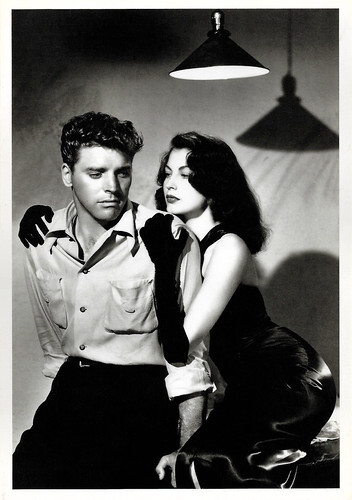
French postcard in the Collection Magie Noireby Éditions Hazan, Paris, 1990, no. 6231. Burt Lancaster and Ava Gardner in The Killers (Robert Siodmak, 1946).

German postcard by Ross Verlag, no. 6424/1, 1931-1932. Photo: Ufa. Emil Jannings in Stürme der Leidenschaft / The Tempest (Robert Siodmak, 1931).

German postcard by Ross Verlag, no. 5563/1, 1930-1931. Photo: Ufa. Heinz Rühmann and Lien Deyers in Der Mann, der seinen Mörder sucht / The Man in Search of His Murderer (Robert Siodmak, 1931).

German postcard by Agfa. Photo: Ufa. Hans Albers and Lilian Harvey in Quick (Robert Siodmak, 1932).
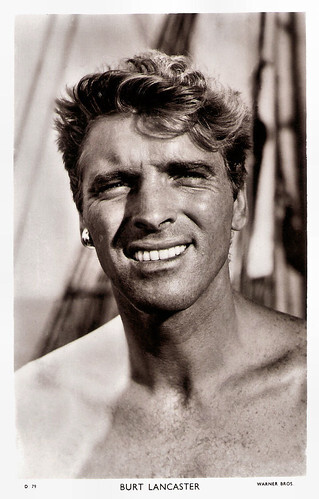
British postcard in the Picturegoer Series, no. D 79. Photo: Warner Bros. Burt Lancaster in The Crimson Pirate (Robert Siodmak, 1952).
A masterpiece and one of the most important examples of Neuen Sachlichkeit
Robert Siodmak was born in Dresden, in the German Empire in 1900. He was born to German Jewish parents, the merchant Ignatz Siodmak and his wife Rosa Philippine, née Blum. Ignatz Siodmak came from Silesia, emigrated to America and then settled in Germany as an American citizen in 1899, where he married. Robert's younger brother Kurt Siodmak (later Curt Siodmak) was also born there in 1902. Their mother died of cancer before her 40th birthday and their youngest brother Rolf later committed suicide at the age of 20.
Siodmak attended grammar school in Dresden and took acting lessons with Erich Ponto . He broke with his father and joined a travelling theatre company in 1918. In 1921 he worked as an accountant at the Mattersdorf and Schermer banks in Dresden, in 1924 he founded the publishing house Robert Siodmak and briefly edited the magazine Das Magazin. At Nero-Film AG in Berlin, run by his uncle Heinrich Nebenzahl, he established himself as an editor and assistant director for films by Harry Piel and Kurt Bernhardt.
Siodmak worked at Nero for two years before he finally persuaded Nebenzal to finance his first silent feature. The script was written by his brother Kurt and two beginners who would later become famous, Billy Wilder (then Billie Wilder) and Fred Zinnemann. He co-directed it with Edgar G. Ulmer with a cast of non-professionals. The result, the semi-documentary Menschen am Sonntag / People on Sunday (1930) was a masterpiece and one of the most important examples of Neuen Sachlichkeit (New Objectivity) in German cinema.
Siodmak received a contract with the Ufa, for which he directed film dramas, crime films and film comedies with famous stars. His first Ufa film was the sound comedy Abschied / Farewell (1930) written by Emeric Pressburger and Irma von Cube and starring Brigitte Horney . It was followed by a quite different and unusual comedy, Der Mann, der seinen Mörder sucht / The Man in Search of His Murderer (1931), written by Billy Wilder and starring Heinz Rühmann . In his next film, the crime thriller Stürme der Leidenschaft / Storms of Passion (1932), with Emil Jannings and Anna Sten , Siodmak found a style that would become his own. It is regarded as a precursor of Film Noir. He left the Ufa in 1932 when he was passed over because of his Jewish roots for F.P.1 antwortet nicht, a film adaptation of Kurt Siodmak's novel. He then directed Brennendes Geheimnis / Burning Secret (1933), a screen version of Stefan Zweig's novel. The film was banned after the National Socialists seized power. Joseph Goebbels' recently established Reich Ministry for Popular Enlightenment and Propaganda suspected allusions to the Reichstag fire of 27 February 1933.
Siodmak fled Germany and went to France. In Paris, he worked for the Néro-Films of his cousin Seymour Nebenzahl, who, like Siodmak, had been forced to emigrate. His creativity flourished, as he worked for the next six years in a variety of film genres. He made comedies and musicals like Le Sexe faible / The Weaker Sex (1933) starring Mireille Balin , La crise est finie / The Crisis is Over (1934) with Albert Préjean and Danielle Darrieux , and La Vie parisienne / Parisian Life (1936) starring Max Dearly and Conchita Montenegro . The thriller Pièges / Personal Column (1939), starring Maurice Chevalier, Marie Déa and Erich von Stroheim, was Siodmak’s greatest public success of this creative period. His plan to film Ödön von Horváth's novel ‘Jugend ohne Gott’ failed due to the author's sudden death in an accident.
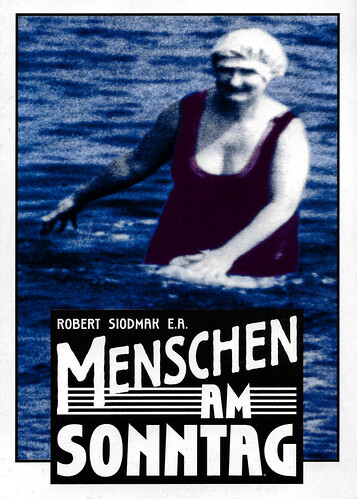
Dutch postcard by Filmmuseum, Amsterdam. Photo: Filmmuseum. Poster for Menschen am Sonntag / People on Sunday (Robert Siodmak, Edgar G. Ulmer, 1930).
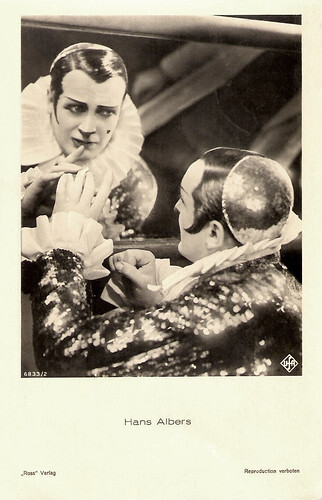
German postcard by Ross Verlag, no. 6833/2, 1931-1932. Photo: Ufa. Hans Albers in Quick (Robert Siodmak, 1932).
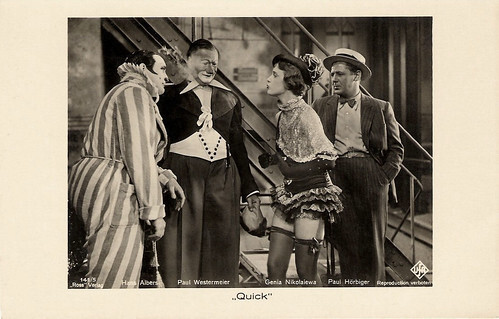
German postcard by Ross Verlag, no. 141/5, 1931-1932. Photo: Ufa. Hans Albers , Paul Hörbiger , Paul Westermeier and Genia Nikolaieva in Quick (Robert Siodmak, 1931).
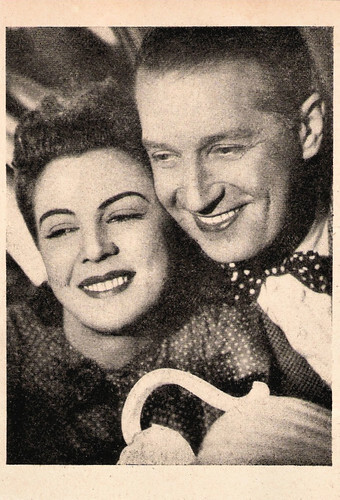
German postcard. Photo: IFA. Marie Déa and Maurice Chevalier in Pièges / Personal Column (Robert Siodmak, 1939).
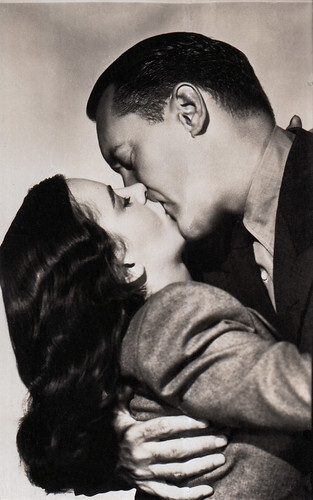
Spanish postcard. Ella Raines and George Sanders in The Strange Affair of Uncle Henry (Robert Siodmak, 1945). Collection: Marlene Pilaete.
Blending German expressionism and French existentialism with American angst
When the Second World War started, Robert Siodmak had to flee the Nazis again and he arrived in California in 1939. His first American film was the comedy West Point Widow (1941) with Anne Shirley. He initially turned out several B-films and programmers for Paramount Pictures, 20th Century Fox and Republic Pictures. Siodmak later called these films “mere bread-and-butter work”.
In 1943, he signed a seven-year contract with Universal Studios and his first Universal production was Dracula's Son (1943), based on his brother Curt Siodmak's original story. Siodmak drew an uncharacteristically controlled and coldly menacing performance from Lon Chaney Jr. for the film. It was Universal's best-performing film in either the Horror or Science Fiction genres during this period. His second feature was the Maria Montez Camp classic, Cobra Woman (1944), made in Technicolor.
His first Film Noir was Phantom Lady (1944), for producer Joan Harrison, Universal's first female executive and Alfred Hitchcock 's former secretary and script assistant. In Phantom Lady (1944), Alan Curtis stalks the streets and bars in search of a mysterious lady, played by Ella Raines . In a few years, Siodmak developed into a formidable director of suspense and crime films. In The Spiral Staircase (1945), mute Dorothy McGuire and widowed invalid Ethel Barrymore are stalked by a serial killer of women with physical handicaps. The film was a box-office success, praised for its cinematography, atmosphere, and suspense, and Barrymore received an Oscar nomination.
In The Killers (1946) a boxer, Burt Lancaster in his film debut, stoically awaits the arrival of his killers in the deep shadows of his room. The film was a great commercial and critical success and launched Lancaster and his co-star Ava Gardner to stardom. Siodmak was influenced by the German schools of expressionism and realism of the 1920s. Film Noir gave him the opportunity to use his pictorial sense and his narrative skills. His string of atmospheric thrillers also included The Suspect (1944), Christmas Holiday (1944), The Strange Affair of Uncle Harry (1945), The Dark Mirror (1946), Cry of the City (1948) and Criss Cross (1949).
David Parkinson at BFI : “Siodmak didn’t patent the noir formula, but he showed how to blend German expressionism and French existentialism with American angst and, in the process, he directed more canonical landmarks than anyone else in the new genre’s heyday. Dismayed by the world around him, Siodmak examined societal injustice, domestic turmoil, gender conflict, sexual repression, psychological trauma and the rise of the career criminal.” Siodmak’s Film Noir series ended with The File on Thelma Jordon (1950) with Barbara Stanwyck . Siodmak turned down a new seven-year contract offer from Universal. In 1952, he made the amusing Swashbuckler The Crimson Pirate (1952), his last American film before leaving his adopted country. The shooting was characterised by ongoing disputes between him and Burt Lancaster , who had become a star since The Killers (1946). Siodmak preferred the old Hollywood studio system, which was dying out at the end of the 1940s, to the new studio conditions, in which, in his words, ‘anarchy’ prevailed and ‘egomaniacal’ stars were in charge.
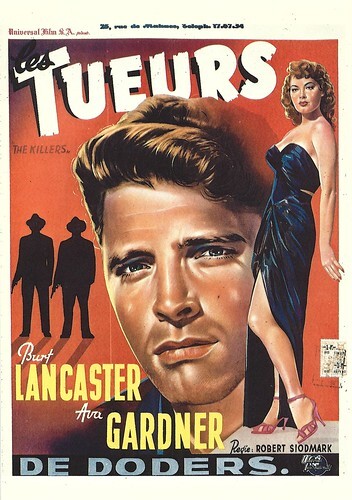
French postcard by Editions Humour à la carte, Paris. Belgian poster for the film The Killers (Robert Siodmak, 1946), starring Burt Lancaster and Ava Gardner .
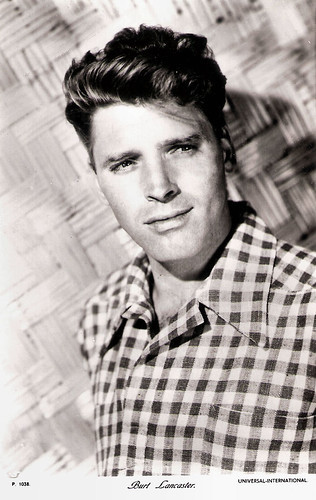
British postcard in The People series by Show Parade Picture Service, London, no. P. 1038. Photo: Universal International. Burt Lancaster in Criss Cross (Robert Siodmak, 1949).
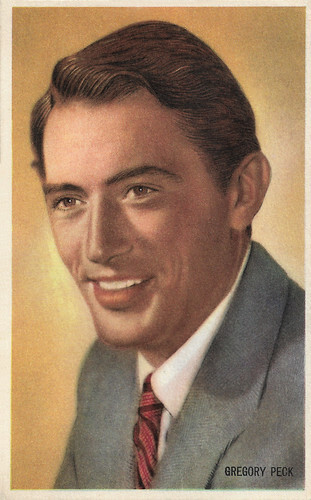
Belgian collector card by Kwatta, Bois-d'Haine, no. C. 245. Photo: MGM. Gregory Peck in The Great Sinner (Robert Siodmak, 1949).
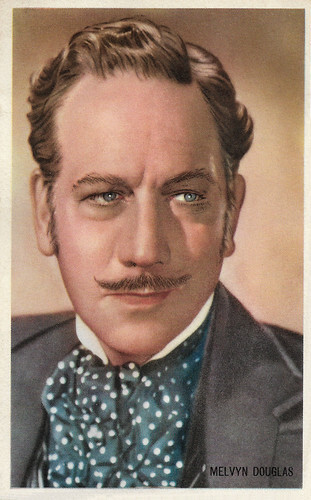
Belgian collector card by Kwatta, Bois d'Haine, no. C. 270. Photo: MGM. Melvyn Douglas in The Great Sinner (Robert Siodmak, 1949).
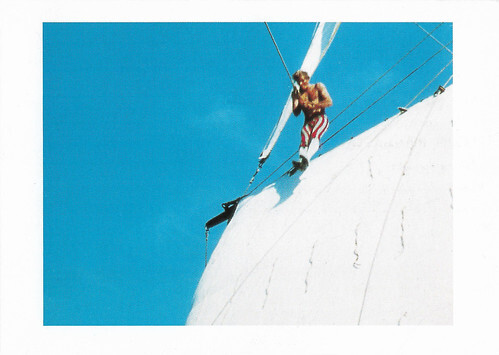
French postcard by Ecole et Cinema. Burt Lancaster in The Crimson Pirate (Robert Siodmak, 1952).
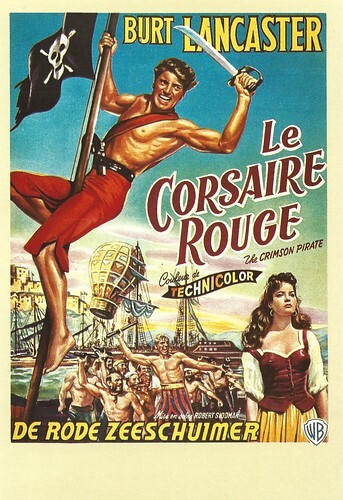
French postcard by Editions Zreik, Paris,i n collection Télérama, la mémoire du cinéma. Belgian poster for the film The Crimson Pirate (Robert Siodmak, 1952), starring Burt Lancaster .
Films critical of his homeland, during and after Hitler
Robert Siodmak returned to Europe. A further reason for his departure from Hollywood was that he was targeted by the House Committee on Un-American Activities (HUAC), which in the 1940s and 1950s scrutinised film-makers for their political views. Siodmak is said to have rewritten the screenplay of The Crimson Pirate, originally written by Waldo Salt, as a comedy within two days. Salt was accused of being a communist eight days before the shooting began and his screenplay was therefore not allowed to be filmed. Siodmak settled in Ascona on the Swiss shore of Lake Maggiore.
In France, he directed Gina Lollobrigida in the drama Le Grand Jeu / Flesh and the Woman (1954) which was entered into the 1954 Cannes Film Festival. The next year, he returned to West Germany to make Die Ratten / The Rats (1955), with Maria Schell and Curd Jurgens . The film, an adaptation of Gerhart Hauptmann's play of the same name won the Golden Berlin Bear at the 1955 Berlin Film Festival. It was the first in a series of films critical of his homeland, during and after Hitler.
His production Nachts, wenn der Teufel kam / The Devil Strikes at Night (1957) was based on the story of Bruno Lüdke (played by Mario Adorf ), who was falsely accused of being a serial killer by the Nazis. The film was nominated for Best Foreign Language Film. In his autobiography, Siodmak noted that of the films he made after returning from the USA, he was only proud of these two. In the 1950s and 1960s, he worked in such diverse fields as crime films, film dramas, Westerns and historical films, and most of these films were profitable at the box office, if not always successful with the critics.
Mein Schulfreund / My Schoolfriend (1960) with Heinz Rühmann and L'affaire Nina B. / Affäre Nina B. / The Nina B. Affair (1961) with Pierre Brasseur and Nadja Tiller had National Socialism as their thematic background. Siodmak directed three Karl May film adaptations with Lex Barker : Der Schut / The Shoot (1964), Der Schatz der Azteken / The Treasure of the Aztecs (1965) and the sequel Die Pyramide des Sonnengottes / The Pyramid of the Sun God (1965). In Spain, Siodmak shot the epic Western Custer of the West (1967) for American producer Philip Yordan. It presents a highly fictionalised version of the life and death of George Armstrong Custer, starring Robert Shaw as Custer. The film was a disappointment, receiving mostly negative reviews from critics and failing to generate box-office appeal.
For German producer Artur Brauner, he directed the two-part monumental film Kampf um Rom/ Battle for Rome (1968-1969), starring Laurence Harvey and Orson Welles . It was Siodmak's last film and another disappointment. He made a brief appearance in Thomas Schamoni's thriller Ein großer graublauer Vogel / A Great Grey-Blue Bird (1970). His wife Bertha, whom he had married in Paris in 1933, died in 1973. Two months later, Robert Siodmak succumbed to a heart attack in Locarno, Switzerland. He was 72. In 1998, the Berlin International Film Festival dedicated a retrospective to the Siodmak brothers, which was attended by Curt Siodmak, who died two years later.
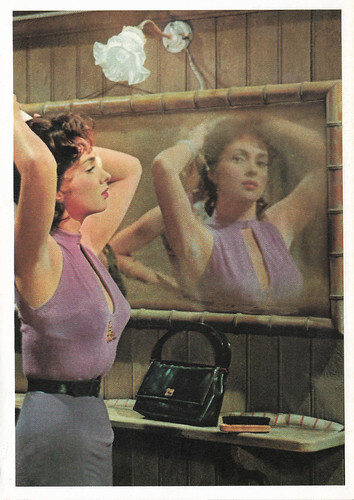
French postcard in the collection Cinéma Couleur by Editions La Malibran, Nancy, no. MC 37, 1990. Photo: Gina Lollobrigida in Le grand jeu / Card of Fate (Robert Siodmak, 1954).
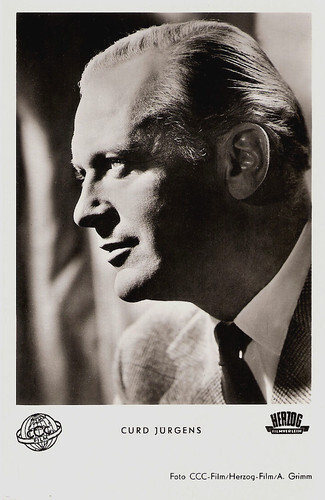
German postcard by Kunst und Bild, Berlin, no. I 409. Photo: CCC-Film / Herzog-Film / A. Grimm. Curd Jürgens in Die Ratten / The Rats (Robert Siodmak, 1955).
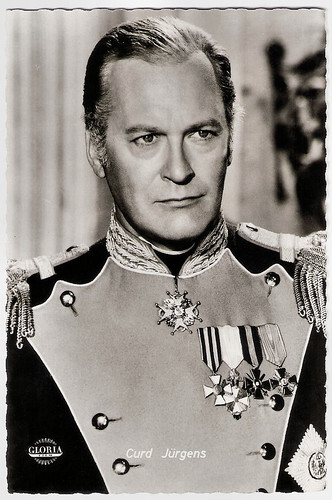
German postcard by Kolibri-Verlag G.m.b.H., Minden/Westf., no. 996. Photo: Speva / Gloria-Film. Curd Jürgens in Katia/Adorable Sinner (Robert Siodmak, 1959).
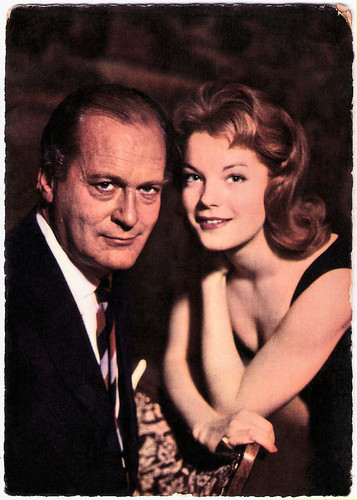
German postcard by ISV, no. 4. Curd Jürgens and Romy Schneider in Katia / Adorable Sinner (Robert Siodmak, 1959).

West-German postcard by Heinerle Karl-May-Postkarten, no. 25. Photo: CCC / Gloria-Verleih. Pierre Fromont and Marie Versini in Der Schut/The Shoot (Robert Siodmak, 1964). Caption: "Monsieur Galingré - for God's sake what are you doing!" - "Don't mind me! Get out of here as fast as you can, or you'll be lost!" - "You'll pay for this, Frenchman, you scoundrel!"
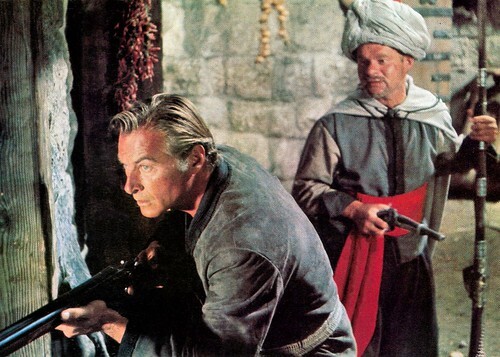
German postcard by Heinerle Karl-May-Postkarten, no. 40. Photo: CCC / Gloria. Lex Barker and Ralf Wolter in Der Schut / The Shoot (Robert Siodmak, 1964). Caption: Kara, who suddenly missed his faithful servant, has followed in his footsteps, and could free him in time from the clutches of the bandits. Kara now takes each bandit on the grain with his dreaded bear hunter.
Sources: David Parkinson (BFI), They Shoot Pictures, Don’t They, Wikipedia (Dutch, German and French) and .

French postcard in the Collection Magie Noireby Éditions Hazan, Paris, 1990, no. 6231. Burt Lancaster and Ava Gardner in The Killers (Robert Siodmak, 1946).

German postcard by Ross Verlag, no. 6424/1, 1931-1932. Photo: Ufa. Emil Jannings in Stürme der Leidenschaft / The Tempest (Robert Siodmak, 1931).

German postcard by Ross Verlag, no. 5563/1, 1930-1931. Photo: Ufa. Heinz Rühmann and Lien Deyers in Der Mann, der seinen Mörder sucht / The Man in Search of His Murderer (Robert Siodmak, 1931).

German postcard by Agfa. Photo: Ufa. Hans Albers and Lilian Harvey in Quick (Robert Siodmak, 1932).

British postcard in the Picturegoer Series, no. D 79. Photo: Warner Bros. Burt Lancaster in The Crimson Pirate (Robert Siodmak, 1952).
A masterpiece and one of the most important examples of Neuen Sachlichkeit
Robert Siodmak was born in Dresden, in the German Empire in 1900. He was born to German Jewish parents, the merchant Ignatz Siodmak and his wife Rosa Philippine, née Blum. Ignatz Siodmak came from Silesia, emigrated to America and then settled in Germany as an American citizen in 1899, where he married. Robert's younger brother Kurt Siodmak (later Curt Siodmak) was also born there in 1902. Their mother died of cancer before her 40th birthday and their youngest brother Rolf later committed suicide at the age of 20.
Siodmak attended grammar school in Dresden and took acting lessons with Erich Ponto . He broke with his father and joined a travelling theatre company in 1918. In 1921 he worked as an accountant at the Mattersdorf and Schermer banks in Dresden, in 1924 he founded the publishing house Robert Siodmak and briefly edited the magazine Das Magazin. At Nero-Film AG in Berlin, run by his uncle Heinrich Nebenzahl, he established himself as an editor and assistant director for films by Harry Piel and Kurt Bernhardt.
Siodmak worked at Nero for two years before he finally persuaded Nebenzal to finance his first silent feature. The script was written by his brother Kurt and two beginners who would later become famous, Billy Wilder (then Billie Wilder) and Fred Zinnemann. He co-directed it with Edgar G. Ulmer with a cast of non-professionals. The result, the semi-documentary Menschen am Sonntag / People on Sunday (1930) was a masterpiece and one of the most important examples of Neuen Sachlichkeit (New Objectivity) in German cinema.
Siodmak received a contract with the Ufa, for which he directed film dramas, crime films and film comedies with famous stars. His first Ufa film was the sound comedy Abschied / Farewell (1930) written by Emeric Pressburger and Irma von Cube and starring Brigitte Horney . It was followed by a quite different and unusual comedy, Der Mann, der seinen Mörder sucht / The Man in Search of His Murderer (1931), written by Billy Wilder and starring Heinz Rühmann . In his next film, the crime thriller Stürme der Leidenschaft / Storms of Passion (1932), with Emil Jannings and Anna Sten , Siodmak found a style that would become his own. It is regarded as a precursor of Film Noir. He left the Ufa in 1932 when he was passed over because of his Jewish roots for F.P.1 antwortet nicht, a film adaptation of Kurt Siodmak's novel. He then directed Brennendes Geheimnis / Burning Secret (1933), a screen version of Stefan Zweig's novel. The film was banned after the National Socialists seized power. Joseph Goebbels' recently established Reich Ministry for Popular Enlightenment and Propaganda suspected allusions to the Reichstag fire of 27 February 1933.
Siodmak fled Germany and went to France. In Paris, he worked for the Néro-Films of his cousin Seymour Nebenzahl, who, like Siodmak, had been forced to emigrate. His creativity flourished, as he worked for the next six years in a variety of film genres. He made comedies and musicals like Le Sexe faible / The Weaker Sex (1933) starring Mireille Balin , La crise est finie / The Crisis is Over (1934) with Albert Préjean and Danielle Darrieux , and La Vie parisienne / Parisian Life (1936) starring Max Dearly and Conchita Montenegro . The thriller Pièges / Personal Column (1939), starring Maurice Chevalier, Marie Déa and Erich von Stroheim, was Siodmak’s greatest public success of this creative period. His plan to film Ödön von Horváth's novel ‘Jugend ohne Gott’ failed due to the author's sudden death in an accident.

Dutch postcard by Filmmuseum, Amsterdam. Photo: Filmmuseum. Poster for Menschen am Sonntag / People on Sunday (Robert Siodmak, Edgar G. Ulmer, 1930).

German postcard by Ross Verlag, no. 6833/2, 1931-1932. Photo: Ufa. Hans Albers in Quick (Robert Siodmak, 1932).

German postcard by Ross Verlag, no. 141/5, 1931-1932. Photo: Ufa. Hans Albers , Paul Hörbiger , Paul Westermeier and Genia Nikolaieva in Quick (Robert Siodmak, 1931).

German postcard. Photo: IFA. Marie Déa and Maurice Chevalier in Pièges / Personal Column (Robert Siodmak, 1939).

Spanish postcard. Ella Raines and George Sanders in The Strange Affair of Uncle Henry (Robert Siodmak, 1945). Collection: Marlene Pilaete.
Blending German expressionism and French existentialism with American angst
When the Second World War started, Robert Siodmak had to flee the Nazis again and he arrived in California in 1939. His first American film was the comedy West Point Widow (1941) with Anne Shirley. He initially turned out several B-films and programmers for Paramount Pictures, 20th Century Fox and Republic Pictures. Siodmak later called these films “mere bread-and-butter work”.
In 1943, he signed a seven-year contract with Universal Studios and his first Universal production was Dracula's Son (1943), based on his brother Curt Siodmak's original story. Siodmak drew an uncharacteristically controlled and coldly menacing performance from Lon Chaney Jr. for the film. It was Universal's best-performing film in either the Horror or Science Fiction genres during this period. His second feature was the Maria Montez Camp classic, Cobra Woman (1944), made in Technicolor.
His first Film Noir was Phantom Lady (1944), for producer Joan Harrison, Universal's first female executive and Alfred Hitchcock 's former secretary and script assistant. In Phantom Lady (1944), Alan Curtis stalks the streets and bars in search of a mysterious lady, played by Ella Raines . In a few years, Siodmak developed into a formidable director of suspense and crime films. In The Spiral Staircase (1945), mute Dorothy McGuire and widowed invalid Ethel Barrymore are stalked by a serial killer of women with physical handicaps. The film was a box-office success, praised for its cinematography, atmosphere, and suspense, and Barrymore received an Oscar nomination.
In The Killers (1946) a boxer, Burt Lancaster in his film debut, stoically awaits the arrival of his killers in the deep shadows of his room. The film was a great commercial and critical success and launched Lancaster and his co-star Ava Gardner to stardom. Siodmak was influenced by the German schools of expressionism and realism of the 1920s. Film Noir gave him the opportunity to use his pictorial sense and his narrative skills. His string of atmospheric thrillers also included The Suspect (1944), Christmas Holiday (1944), The Strange Affair of Uncle Harry (1945), The Dark Mirror (1946), Cry of the City (1948) and Criss Cross (1949).
David Parkinson at BFI : “Siodmak didn’t patent the noir formula, but he showed how to blend German expressionism and French existentialism with American angst and, in the process, he directed more canonical landmarks than anyone else in the new genre’s heyday. Dismayed by the world around him, Siodmak examined societal injustice, domestic turmoil, gender conflict, sexual repression, psychological trauma and the rise of the career criminal.” Siodmak’s Film Noir series ended with The File on Thelma Jordon (1950) with Barbara Stanwyck . Siodmak turned down a new seven-year contract offer from Universal. In 1952, he made the amusing Swashbuckler The Crimson Pirate (1952), his last American film before leaving his adopted country. The shooting was characterised by ongoing disputes between him and Burt Lancaster , who had become a star since The Killers (1946). Siodmak preferred the old Hollywood studio system, which was dying out at the end of the 1940s, to the new studio conditions, in which, in his words, ‘anarchy’ prevailed and ‘egomaniacal’ stars were in charge.

French postcard by Editions Humour à la carte, Paris. Belgian poster for the film The Killers (Robert Siodmak, 1946), starring Burt Lancaster and Ava Gardner .

British postcard in The People series by Show Parade Picture Service, London, no. P. 1038. Photo: Universal International. Burt Lancaster in Criss Cross (Robert Siodmak, 1949).

Belgian collector card by Kwatta, Bois-d'Haine, no. C. 245. Photo: MGM. Gregory Peck in The Great Sinner (Robert Siodmak, 1949).

Belgian collector card by Kwatta, Bois d'Haine, no. C. 270. Photo: MGM. Melvyn Douglas in The Great Sinner (Robert Siodmak, 1949).

French postcard by Ecole et Cinema. Burt Lancaster in The Crimson Pirate (Robert Siodmak, 1952).

French postcard by Editions Zreik, Paris,i n collection Télérama, la mémoire du cinéma. Belgian poster for the film The Crimson Pirate (Robert Siodmak, 1952), starring Burt Lancaster .
Films critical of his homeland, during and after Hitler
Robert Siodmak returned to Europe. A further reason for his departure from Hollywood was that he was targeted by the House Committee on Un-American Activities (HUAC), which in the 1940s and 1950s scrutinised film-makers for their political views. Siodmak is said to have rewritten the screenplay of The Crimson Pirate, originally written by Waldo Salt, as a comedy within two days. Salt was accused of being a communist eight days before the shooting began and his screenplay was therefore not allowed to be filmed. Siodmak settled in Ascona on the Swiss shore of Lake Maggiore.
In France, he directed Gina Lollobrigida in the drama Le Grand Jeu / Flesh and the Woman (1954) which was entered into the 1954 Cannes Film Festival. The next year, he returned to West Germany to make Die Ratten / The Rats (1955), with Maria Schell and Curd Jurgens . The film, an adaptation of Gerhart Hauptmann's play of the same name won the Golden Berlin Bear at the 1955 Berlin Film Festival. It was the first in a series of films critical of his homeland, during and after Hitler.
His production Nachts, wenn der Teufel kam / The Devil Strikes at Night (1957) was based on the story of Bruno Lüdke (played by Mario Adorf ), who was falsely accused of being a serial killer by the Nazis. The film was nominated for Best Foreign Language Film. In his autobiography, Siodmak noted that of the films he made after returning from the USA, he was only proud of these two. In the 1950s and 1960s, he worked in such diverse fields as crime films, film dramas, Westerns and historical films, and most of these films were profitable at the box office, if not always successful with the critics.
Mein Schulfreund / My Schoolfriend (1960) with Heinz Rühmann and L'affaire Nina B. / Affäre Nina B. / The Nina B. Affair (1961) with Pierre Brasseur and Nadja Tiller had National Socialism as their thematic background. Siodmak directed three Karl May film adaptations with Lex Barker : Der Schut / The Shoot (1964), Der Schatz der Azteken / The Treasure of the Aztecs (1965) and the sequel Die Pyramide des Sonnengottes / The Pyramid of the Sun God (1965). In Spain, Siodmak shot the epic Western Custer of the West (1967) for American producer Philip Yordan. It presents a highly fictionalised version of the life and death of George Armstrong Custer, starring Robert Shaw as Custer. The film was a disappointment, receiving mostly negative reviews from critics and failing to generate box-office appeal.
For German producer Artur Brauner, he directed the two-part monumental film Kampf um Rom/ Battle for Rome (1968-1969), starring Laurence Harvey and Orson Welles . It was Siodmak's last film and another disappointment. He made a brief appearance in Thomas Schamoni's thriller Ein großer graublauer Vogel / A Great Grey-Blue Bird (1970). His wife Bertha, whom he had married in Paris in 1933, died in 1973. Two months later, Robert Siodmak succumbed to a heart attack in Locarno, Switzerland. He was 72. In 1998, the Berlin International Film Festival dedicated a retrospective to the Siodmak brothers, which was attended by Curt Siodmak, who died two years later.

French postcard in the collection Cinéma Couleur by Editions La Malibran, Nancy, no. MC 37, 1990. Photo: Gina Lollobrigida in Le grand jeu / Card of Fate (Robert Siodmak, 1954).

German postcard by Kunst und Bild, Berlin, no. I 409. Photo: CCC-Film / Herzog-Film / A. Grimm. Curd Jürgens in Die Ratten / The Rats (Robert Siodmak, 1955).

German postcard by Kolibri-Verlag G.m.b.H., Minden/Westf., no. 996. Photo: Speva / Gloria-Film. Curd Jürgens in Katia/Adorable Sinner (Robert Siodmak, 1959).

German postcard by ISV, no. 4. Curd Jürgens and Romy Schneider in Katia / Adorable Sinner (Robert Siodmak, 1959).

West-German postcard by Heinerle Karl-May-Postkarten, no. 25. Photo: CCC / Gloria-Verleih. Pierre Fromont and Marie Versini in Der Schut/The Shoot (Robert Siodmak, 1964). Caption: "Monsieur Galingré - for God's sake what are you doing!" - "Don't mind me! Get out of here as fast as you can, or you'll be lost!" - "You'll pay for this, Frenchman, you scoundrel!"

German postcard by Heinerle Karl-May-Postkarten, no. 40. Photo: CCC / Gloria. Lex Barker and Ralf Wolter in Der Schut / The Shoot (Robert Siodmak, 1964). Caption: Kara, who suddenly missed his faithful servant, has followed in his footsteps, and could free him in time from the clutches of the bandits. Kara now takes each bandit on the grain with his dreaded bear hunter.
Sources: David Parkinson (BFI), They Shoot Pictures, Don’t They, Wikipedia (Dutch, German and French) and .
Published on August 07, 2025 22:00
August 6, 2025
Ingeborg von Kusserow
German actress Ingeborg von Kusserow (1919-2014) enjoyed a flourishing career in the 1930s, first in the theatre and then as a young Ufa star. In 1947, she went to Great Britain, where she filmed under the name Ingeborg Wells.
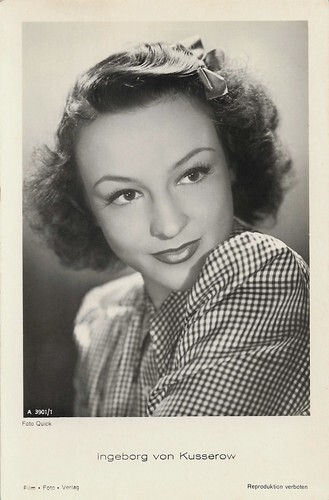
German postcard by Film-Foto-Verlag, no. A 3901/1, 1941-1944. Photo: Quick.
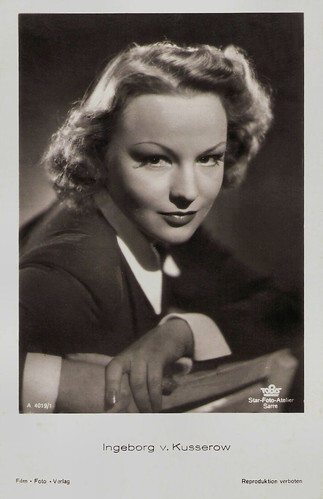
German postcard by Film-Foto-Verlag, no. A 4019/1, 1941-1944. Photo: Sarre / Star-Foto-Atelier / Tobis.
Young, capricious women or society girls
Ingeborg Maria von Kusserow was born in 1919 in Wollstein, during the Weimar Republic; now Wolsztyn, Poland. Her father, Curt von Kusserow, came from an old noble family in East Elbia. She received dance and ballet training as a child.
As a teenager, she began her career as a singer, dancer and actress in Berlin. She performed at the Berlin Opera, the Metropol Theatre and the Schlosspark Theatre. In 1936, she made her film debut at Ufa in the Operetta film Das Hofkonzert / The Court Concert (Detlef Sierck, a.k.a. Douglas Sirk, 1936) starring Márta Eggerth and Johannes Heesters . It was the first of around 30 features and shorts she made in Germany.
She also played a supporting part in a comedy with Johannes Heesters , Wenn Frauen schweigen / When Women Keep Silent (Fritz Kirchhoff, 1937). She was the leading lady in another comedy, Das Mädchen von gestern Nacht / The Girl of Last Night (Peter Paul Brauer, 1938) starring Willy Fritsch .
In the following years, Von Kusserow portrayed many young, capricious women or society girls in several film operettas and melodramas for Ufa. She also starred in Nazi Propaganda films during the Third Reich, which she wrote about in a 1949 memoir 'I Was Hitler's Mickey Mouse'. In 1941, Von Kusserow married Percy Friedrich Graf von Welsburg in 1941. He was a Hungarian national born in England. They hoped to get to Britain via Switzerland, but this proved impossible. They spent the war in Berlin, experiencing all its deprivations and terrors, which she described in the memoir 'Enough, No More' (1948).
However, she continued to make a few films and in 1944, she was on the 'list of godsent' by the Reich Ministry for Popular Enlightenment and Propaganda. In the early 1940s, she also released several records for the Imperial label with Willy Berking's studio orchestra. After the war, she enjoyed success at the West Berlin ‘Rheingau-Theatre’ as Eliza Doolittle in the play ‘Pygmalion' by George Bernard Shaw and at the Schlosspark Theatre with Hans Söhnker in the comedy ‘Dr. med. Hiob Prätorius’ (1947) by Curt Goetz. In 1947, the couple emigrated to Britain and lived in St John's Wood, London. They had one son, Patrick Hubert Welsburg (1943).
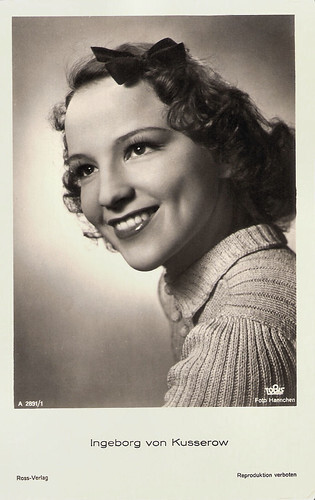
German postcard by Ross Verlag, no. A 2891, 1939-1940. Photo: Tobis / Haenchen.
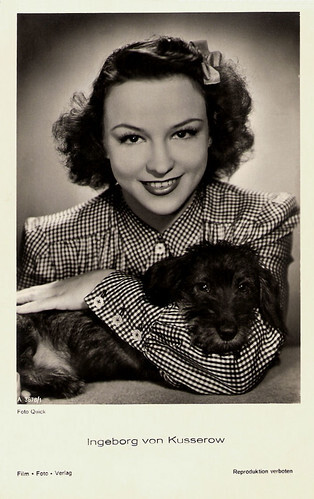
German postcard by Film-Foto-Verlag, no. A 3678/1, 1941-1944. Photo: Quick.
Strong-minded, even at times controlling
In Great Britain, Ingeborg von Kusserow filmed under the name Ingeborg Wells. Her British films included Captain Horatio Hornblower R.N. (Raoul Walsh, 1951) starring Gregory Peck and with a very modest role for Wells and the comedy One Wild Oat (Charles Saunders, 1951) starring Robertson Hare and Stanley Holloway .
In British cinema, she mostly played foreign women, such as in the crime drama Women of Twilight (Gordon Parry, 1952), the first British film to get the new X certificate. Her roles were mainly supporting parts. Her final film was Across the Bridge (Ken Annakin, 1956), based on a short story by Graham Greene. She also appeared in several British TV series, including an episode of The Adventures of Robin Hood (1956).
Kusserow retired in 1963, and two years later, in 1965, she divorced Percy Friedrich Graf von Welsburg. She was invited back to West Berlin to star in a German version of an American play, 'You Know I Can't Hear You When The Water's Running' (1968) by Robert Anderson. She found she was still well remembered by many old fans.
In 1968, she married Kenneth Slingsby-Fahn, a retired RAF officer. Their life together in their garden flat in Abercorn Place has been recounted in a memoir by a neighbour. John Mills in The Independent: "She was strong-minded, even at times controlling. This had made her life with Percy stormy; Kenneth, however, was happy to go along with everything she proposed, and so harmony prevailed during their 40 years together."
In 1979, she and her husband relocated to a cottage in Houghton, West Sussex, where Kenneth died in 2007. Kusserow lived alone until 2013, when she suffered a fall and had to live in a care home until her death a year later. Ingeborg Wells died in 2014 in Hove, East Sussex. She was 95.
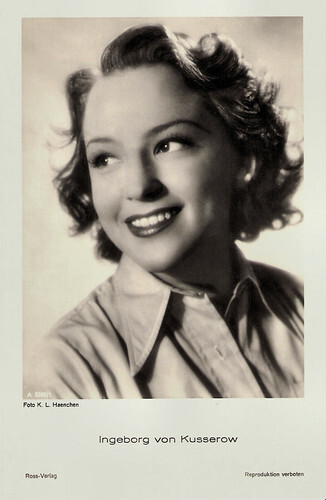
German postcard by Film-Foto-Verlag, no. A 3269/1, 1941-1944. Photo: K.L. Haenchen.
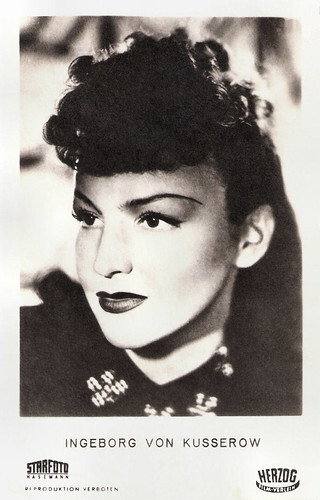
German postcard by Star Foto Hasemann. Photo: Herzog Film-Verleih.

West German collector card by Ross Verlag. Photo: Ufa / Hämmerer.
Sources: John Mills (The Independent), Stephanie D'heil (Steffi-Line - German), Wikipedia (English, French and German) and .

German postcard by Film-Foto-Verlag, no. A 3901/1, 1941-1944. Photo: Quick.

German postcard by Film-Foto-Verlag, no. A 4019/1, 1941-1944. Photo: Sarre / Star-Foto-Atelier / Tobis.
Young, capricious women or society girls
Ingeborg Maria von Kusserow was born in 1919 in Wollstein, during the Weimar Republic; now Wolsztyn, Poland. Her father, Curt von Kusserow, came from an old noble family in East Elbia. She received dance and ballet training as a child.
As a teenager, she began her career as a singer, dancer and actress in Berlin. She performed at the Berlin Opera, the Metropol Theatre and the Schlosspark Theatre. In 1936, she made her film debut at Ufa in the Operetta film Das Hofkonzert / The Court Concert (Detlef Sierck, a.k.a. Douglas Sirk, 1936) starring Márta Eggerth and Johannes Heesters . It was the first of around 30 features and shorts she made in Germany.
She also played a supporting part in a comedy with Johannes Heesters , Wenn Frauen schweigen / When Women Keep Silent (Fritz Kirchhoff, 1937). She was the leading lady in another comedy, Das Mädchen von gestern Nacht / The Girl of Last Night (Peter Paul Brauer, 1938) starring Willy Fritsch .
In the following years, Von Kusserow portrayed many young, capricious women or society girls in several film operettas and melodramas for Ufa. She also starred in Nazi Propaganda films during the Third Reich, which she wrote about in a 1949 memoir 'I Was Hitler's Mickey Mouse'. In 1941, Von Kusserow married Percy Friedrich Graf von Welsburg in 1941. He was a Hungarian national born in England. They hoped to get to Britain via Switzerland, but this proved impossible. They spent the war in Berlin, experiencing all its deprivations and terrors, which she described in the memoir 'Enough, No More' (1948).
However, she continued to make a few films and in 1944, she was on the 'list of godsent' by the Reich Ministry for Popular Enlightenment and Propaganda. In the early 1940s, she also released several records for the Imperial label with Willy Berking's studio orchestra. After the war, she enjoyed success at the West Berlin ‘Rheingau-Theatre’ as Eliza Doolittle in the play ‘Pygmalion' by George Bernard Shaw and at the Schlosspark Theatre with Hans Söhnker in the comedy ‘Dr. med. Hiob Prätorius’ (1947) by Curt Goetz. In 1947, the couple emigrated to Britain and lived in St John's Wood, London. They had one son, Patrick Hubert Welsburg (1943).

German postcard by Ross Verlag, no. A 2891, 1939-1940. Photo: Tobis / Haenchen.

German postcard by Film-Foto-Verlag, no. A 3678/1, 1941-1944. Photo: Quick.
Strong-minded, even at times controlling
In Great Britain, Ingeborg von Kusserow filmed under the name Ingeborg Wells. Her British films included Captain Horatio Hornblower R.N. (Raoul Walsh, 1951) starring Gregory Peck and with a very modest role for Wells and the comedy One Wild Oat (Charles Saunders, 1951) starring Robertson Hare and Stanley Holloway .
In British cinema, she mostly played foreign women, such as in the crime drama Women of Twilight (Gordon Parry, 1952), the first British film to get the new X certificate. Her roles were mainly supporting parts. Her final film was Across the Bridge (Ken Annakin, 1956), based on a short story by Graham Greene. She also appeared in several British TV series, including an episode of The Adventures of Robin Hood (1956).
Kusserow retired in 1963, and two years later, in 1965, she divorced Percy Friedrich Graf von Welsburg. She was invited back to West Berlin to star in a German version of an American play, 'You Know I Can't Hear You When The Water's Running' (1968) by Robert Anderson. She found she was still well remembered by many old fans.
In 1968, she married Kenneth Slingsby-Fahn, a retired RAF officer. Their life together in their garden flat in Abercorn Place has been recounted in a memoir by a neighbour. John Mills in The Independent: "She was strong-minded, even at times controlling. This had made her life with Percy stormy; Kenneth, however, was happy to go along with everything she proposed, and so harmony prevailed during their 40 years together."
In 1979, she and her husband relocated to a cottage in Houghton, West Sussex, where Kenneth died in 2007. Kusserow lived alone until 2013, when she suffered a fall and had to live in a care home until her death a year later. Ingeborg Wells died in 2014 in Hove, East Sussex. She was 95.

German postcard by Film-Foto-Verlag, no. A 3269/1, 1941-1944. Photo: K.L. Haenchen.

German postcard by Star Foto Hasemann. Photo: Herzog Film-Verleih.

West German collector card by Ross Verlag. Photo: Ufa / Hämmerer.
Sources: John Mills (The Independent), Stephanie D'heil (Steffi-Line - German), Wikipedia (English, French and German) and .
Published on August 06, 2025 22:00
August 5, 2025
George Hamilton
Dashing American actor George Hamilton (1939) was one of the last contracted Metro-Goldwyn-Mayer stars. He won a Golden Globe for his film debut in Crime and Punishment U.S.A. (1959). Although he has a substantial body of work in film and television, he is most famous for his debonair style, perpetual suntan and jet-setting playboy image.
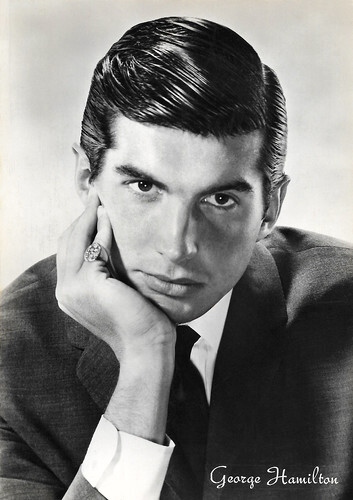
Italian postcard by Rotalfoto, Milano, no. 870.
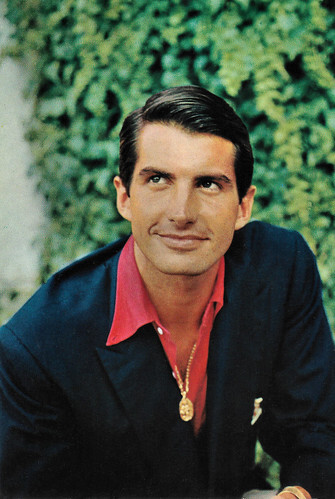
Italian postcard by Rotalfoto, Milano, no. 217.
His exceedingly handsome looks and attractive personality
George Stevens Hamilton was born in Memphis, TN, in 1939. He was the son of Anne Lucille (Stevens) Potter Hamilton Hunt Spaulding and her husband (of four), George William 'Spike' Hamilton, a touring bandleader. George's older half-brother, William Potter, became an interior decorator for Eva Gabor Interiors in Palm Springs. Moving extensively as a youth due to his father's work, young George got a taste of acting in plays while attending Palm Beach High School.
With his exceedingly handsome looks and attractive personality, he took a bold chance and moved to Los Angeles in the late 1950s. MGM saw in George a budding talent with photogenic appeal. After some guest appearances on TV, he made his film debut as the lead in Crime & Punishment, USA (Denis Sanders, 1959), an offbeat, updated adaptation of the Fyodor Dostoevsky novel, set in the beatnik scene. While the film was not overwhelmingly successful, George's heartthrob appeal was obvious. He was awarded a Golden Globe for Most Promising Newcomer and was nominated for Best Foreign Actor by the British Film Academy (BAFTA).
This led to a series of films, including the memorable Southern melodrama Home from the Hill (Vincente Minnelli, 1960), which starred Robert Mitchum and Eleanor Parker and featured another handsome, up-and-coming George (George Peppard). In Angel Baby (Paul Wendkos, 1961), he played an impressionable lad who meets up with evangelist Mercedes McCambridge.
In Light in the Piazza (Guy Green, 1962), he portrayed an Italian playboy who falls madly for American tourist Yvette Mimieux to the ever-growing concern of her mother, Olivia de Havilland . He also appeared in such dreary no-brainers as All the Fine Young Cannibals (Michael Anderson, 1960) with Robert Wagner , the beach party comedy Where the Boys Are (1960), with Dolores Hart, and Looking for Love (Don Weis, 1964). More interesting was the anti-War drama The Victors (Carl Foreman, 1963) in which he was among an all-star cast with fifteen American and European leading players.
He went to Mexico for Viva Maria! (Louis Malle, 1965) with Brigitte Bardot and Jeanne Moreau . Malle cast Hamilton on the strength of his performance in the drama Two Weeks in Another Town (Vincente Minnelli, 1962) starring Kirk Douglas and Edward G. Robinson . Malle said about Hamilton: "He was a personal choice and I am happy with him... He's more interested in being in the social columns — I don't understand — when he should be one of the greatest of his generation". Hamilton also acted in several biopics - as playwright Moss Hart in Act One (Dore Schary, 1963), as ill-fated country star Hank Williams in Your Cheatin' Heart (Gene Nelson, 1964), and as motorcycle daredevil Evel Knievel in Evel Knievel (Marvin J. Chomsky, 1971), a film which he also produced. The rest of the 1960s and 1970s, he rested on his fun-loving, idle-rich charm that bore a close resemblance to his off-camera image in the society pages.
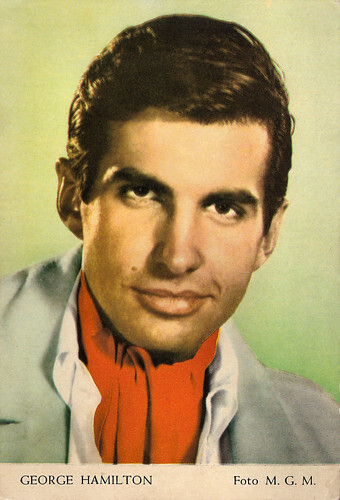
Spanish postcard. Photo: M.G.M.
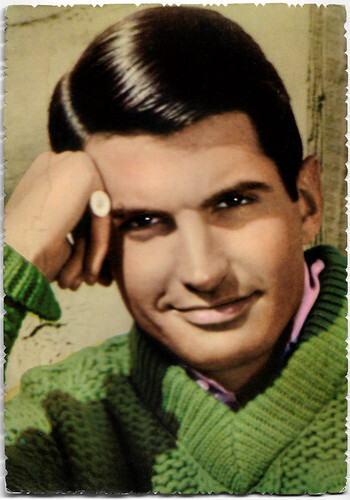
Spanish postcard, no. 9. Photo: Bengala Films. George Hamilton in All the Fine Young Cannibals (Michael Anderson, 1960).
A wonderful comeback in the form of a disco-era Dracula spoof
As the 1960s began to unfold, George Hamilton started making headlines more as a handsome escort to the rich, the powerful and the beautiful than as an acclaimed actor - none more so than his 1966 squiring of President Lyndon B. Johnson's daughter Lynda Bird Johnson. He was also once engaged to actress Susan Kohner, a former co-star. Below-average films such as Doctor, You've Got to Be Kidding! (Peter Tewksbury, 1967) and The Power (Byron Haskin, 1968) effectively ended his initially strong ascent to film stardom.
Hamilton went into television in 1969, supporting Lana Turner in the all-star series Harold Robbins' The Survivors (1969–1970). From the 1970s on, George tended to be tux-prone on standard film and TV comedy and drama, whether as a martini-swirling opportunist, villain or lover. He had a supporting role in The Man Who Loved Cat Dancing (Richard C. Sarafian, 1973), starring Burt Reynolds . He produced and appeared in Medusa (Gordon Hessler, 1973). He starred in the TV movie The Dead Don't Die (Curtis Harrington, 1975) and had a supporting role in Once Is Not Enough (Guy Green, 1975) with Kirk Douglas .
A wonderful comeback for him came in the form of the disco-era Dracula spoof Love at First Bite (Stan Dragoti, 1979), which he executive-produced. Nominated for a Golden Globe as the campy neck-biter displaced and having to fend off the harsh realities of New York living, he continued on the parody road successfully with Zorro: The Gay Blade (Peter Medak, 1981) in the Mel Brooks tradition. Zorro was not as popular as Love at First Bite, and film leads dried up quickly. He focused on television and had a one-year stint on Dynasty during the 1985-1986 season. He also did a string of fun, self-mocking commercials, particularly his Ritz Cracker and (Toasted!) Wheat Thins appearances that often spoofed his overly tanned appearance. In the cinema, he had an interesting supporting part as B. J. Harrison, the Corleones' financial advisor, in The Godfather Part III (Francis Coppola, 1990)
He broke through the reality show ranks by hosting The Family (2003), which starred numerous members of a traditional Italianate family vying for a $1,000,000 prize, and participated in the second season of Dancing with the Stars (2005), where his charm and usual impeccable tailoring scored higher than his limberness. He played flamboyant publisher William Randolph Hearst in the Mini-series Rough Riders (John Milius, 1997), and the best-looking Santa Claus ever in A Very Cool Christmas (Sam Irvin, 2004). In 1989, he started a line of skin-care products and a chain of tanning salons. Into the millennium, he starred with Joe Mantegna and Danny Aiello as three celebrity tenors in Spanish-British-Italian comedy Off Key (Manuel Gómez Pereira, 2001). He also appeared in the Woody Allen comedy Hollywood Ending (2002) and the satire The L.A. Riot Spectacular (Marc Klasfeld, 2005). The comedy-drama My One and Only (Richard Loncraine, 2009), starring Renée Zellweger, is loosely based on George Hamilton's early life on the road with his mother and brother. The film is based on anecdotes that Hamilton had told to producer Robert Kosberg and Merv Griffin.
On TV, Hamilton enhanced several programs, including Nash Bridges, Pushing Daisies, and Hot in Cleveland. He also had a recurring supporting role as billionaire Spencer Blitz in the series American Housewife (2016). In the cinema, he could be seen in the political drama The Congressman (Robert Mrazek, 2016) with Treat Williams, the family dramedy Silver Skies (Rosemary Rodriguez, 2016), and the romantic comedy Swiped (Ann Deborah Fishman, 2018). Beginning in the summer of 2016, Hamilton appeared in TV commercials as the 'Extra Crispy' sun-tanned version of KFC's Colonel Harland Sanders. He later played the Colonel on an episode of General Hospital. In total, his cinematic oeuvre comprises around 130 film and television productions to date. George managed one brief marriage to actress/TV personality Alana Stewart from 1972 to 1975 (she later married and divorced rock singer Rod Stewart), the pair have a son, actor Ashley Hamilton, born in 1974. Another son, George Thomas Hamilton, born in 2000, came from his involvement with Kimberly Blackford. George Hamilton was awarded a Star on the Hollywood Walk of Fame at 7021 Hollywood Boulevard in 2009.
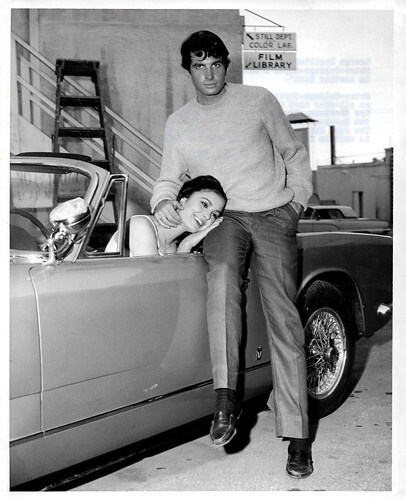
Vintage press photo by Metro-Goldwyn-Mayer. Daliah Lavi and George Hamilton on the set of Two Weeks in Another Town (Vincente Minelli, 1962), filmed in Rome.
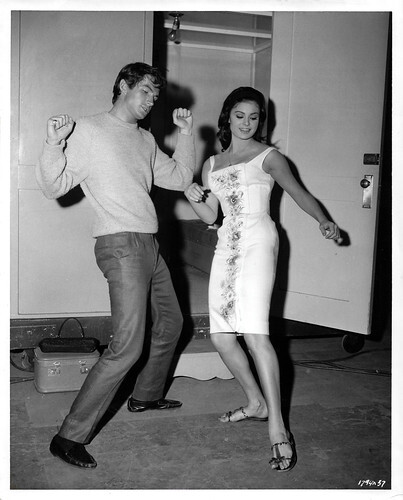
Vintage press photo by Metro-Goldwyn-Mayer. Daliah Lavi and George Hamilton doing the twist on the set of Two Weeks in Another Town (Vincente Minelli, 1962), filmed in Rome.
Sources: (IMDb), Wikipedia (English and German) and .

Italian postcard by Rotalfoto, Milano, no. 870.

Italian postcard by Rotalfoto, Milano, no. 217.
His exceedingly handsome looks and attractive personality
George Stevens Hamilton was born in Memphis, TN, in 1939. He was the son of Anne Lucille (Stevens) Potter Hamilton Hunt Spaulding and her husband (of four), George William 'Spike' Hamilton, a touring bandleader. George's older half-brother, William Potter, became an interior decorator for Eva Gabor Interiors in Palm Springs. Moving extensively as a youth due to his father's work, young George got a taste of acting in plays while attending Palm Beach High School.
With his exceedingly handsome looks and attractive personality, he took a bold chance and moved to Los Angeles in the late 1950s. MGM saw in George a budding talent with photogenic appeal. After some guest appearances on TV, he made his film debut as the lead in Crime & Punishment, USA (Denis Sanders, 1959), an offbeat, updated adaptation of the Fyodor Dostoevsky novel, set in the beatnik scene. While the film was not overwhelmingly successful, George's heartthrob appeal was obvious. He was awarded a Golden Globe for Most Promising Newcomer and was nominated for Best Foreign Actor by the British Film Academy (BAFTA).
This led to a series of films, including the memorable Southern melodrama Home from the Hill (Vincente Minnelli, 1960), which starred Robert Mitchum and Eleanor Parker and featured another handsome, up-and-coming George (George Peppard). In Angel Baby (Paul Wendkos, 1961), he played an impressionable lad who meets up with evangelist Mercedes McCambridge.
In Light in the Piazza (Guy Green, 1962), he portrayed an Italian playboy who falls madly for American tourist Yvette Mimieux to the ever-growing concern of her mother, Olivia de Havilland . He also appeared in such dreary no-brainers as All the Fine Young Cannibals (Michael Anderson, 1960) with Robert Wagner , the beach party comedy Where the Boys Are (1960), with Dolores Hart, and Looking for Love (Don Weis, 1964). More interesting was the anti-War drama The Victors (Carl Foreman, 1963) in which he was among an all-star cast with fifteen American and European leading players.
He went to Mexico for Viva Maria! (Louis Malle, 1965) with Brigitte Bardot and Jeanne Moreau . Malle cast Hamilton on the strength of his performance in the drama Two Weeks in Another Town (Vincente Minnelli, 1962) starring Kirk Douglas and Edward G. Robinson . Malle said about Hamilton: "He was a personal choice and I am happy with him... He's more interested in being in the social columns — I don't understand — when he should be one of the greatest of his generation". Hamilton also acted in several biopics - as playwright Moss Hart in Act One (Dore Schary, 1963), as ill-fated country star Hank Williams in Your Cheatin' Heart (Gene Nelson, 1964), and as motorcycle daredevil Evel Knievel in Evel Knievel (Marvin J. Chomsky, 1971), a film which he also produced. The rest of the 1960s and 1970s, he rested on his fun-loving, idle-rich charm that bore a close resemblance to his off-camera image in the society pages.

Spanish postcard. Photo: M.G.M.

Spanish postcard, no. 9. Photo: Bengala Films. George Hamilton in All the Fine Young Cannibals (Michael Anderson, 1960).
A wonderful comeback in the form of a disco-era Dracula spoof
As the 1960s began to unfold, George Hamilton started making headlines more as a handsome escort to the rich, the powerful and the beautiful than as an acclaimed actor - none more so than his 1966 squiring of President Lyndon B. Johnson's daughter Lynda Bird Johnson. He was also once engaged to actress Susan Kohner, a former co-star. Below-average films such as Doctor, You've Got to Be Kidding! (Peter Tewksbury, 1967) and The Power (Byron Haskin, 1968) effectively ended his initially strong ascent to film stardom.
Hamilton went into television in 1969, supporting Lana Turner in the all-star series Harold Robbins' The Survivors (1969–1970). From the 1970s on, George tended to be tux-prone on standard film and TV comedy and drama, whether as a martini-swirling opportunist, villain or lover. He had a supporting role in The Man Who Loved Cat Dancing (Richard C. Sarafian, 1973), starring Burt Reynolds . He produced and appeared in Medusa (Gordon Hessler, 1973). He starred in the TV movie The Dead Don't Die (Curtis Harrington, 1975) and had a supporting role in Once Is Not Enough (Guy Green, 1975) with Kirk Douglas .
A wonderful comeback for him came in the form of the disco-era Dracula spoof Love at First Bite (Stan Dragoti, 1979), which he executive-produced. Nominated for a Golden Globe as the campy neck-biter displaced and having to fend off the harsh realities of New York living, he continued on the parody road successfully with Zorro: The Gay Blade (Peter Medak, 1981) in the Mel Brooks tradition. Zorro was not as popular as Love at First Bite, and film leads dried up quickly. He focused on television and had a one-year stint on Dynasty during the 1985-1986 season. He also did a string of fun, self-mocking commercials, particularly his Ritz Cracker and (Toasted!) Wheat Thins appearances that often spoofed his overly tanned appearance. In the cinema, he had an interesting supporting part as B. J. Harrison, the Corleones' financial advisor, in The Godfather Part III (Francis Coppola, 1990)
He broke through the reality show ranks by hosting The Family (2003), which starred numerous members of a traditional Italianate family vying for a $1,000,000 prize, and participated in the second season of Dancing with the Stars (2005), where his charm and usual impeccable tailoring scored higher than his limberness. He played flamboyant publisher William Randolph Hearst in the Mini-series Rough Riders (John Milius, 1997), and the best-looking Santa Claus ever in A Very Cool Christmas (Sam Irvin, 2004). In 1989, he started a line of skin-care products and a chain of tanning salons. Into the millennium, he starred with Joe Mantegna and Danny Aiello as three celebrity tenors in Spanish-British-Italian comedy Off Key (Manuel Gómez Pereira, 2001). He also appeared in the Woody Allen comedy Hollywood Ending (2002) and the satire The L.A. Riot Spectacular (Marc Klasfeld, 2005). The comedy-drama My One and Only (Richard Loncraine, 2009), starring Renée Zellweger, is loosely based on George Hamilton's early life on the road with his mother and brother. The film is based on anecdotes that Hamilton had told to producer Robert Kosberg and Merv Griffin.
On TV, Hamilton enhanced several programs, including Nash Bridges, Pushing Daisies, and Hot in Cleveland. He also had a recurring supporting role as billionaire Spencer Blitz in the series American Housewife (2016). In the cinema, he could be seen in the political drama The Congressman (Robert Mrazek, 2016) with Treat Williams, the family dramedy Silver Skies (Rosemary Rodriguez, 2016), and the romantic comedy Swiped (Ann Deborah Fishman, 2018). Beginning in the summer of 2016, Hamilton appeared in TV commercials as the 'Extra Crispy' sun-tanned version of KFC's Colonel Harland Sanders. He later played the Colonel on an episode of General Hospital. In total, his cinematic oeuvre comprises around 130 film and television productions to date. George managed one brief marriage to actress/TV personality Alana Stewart from 1972 to 1975 (she later married and divorced rock singer Rod Stewart), the pair have a son, actor Ashley Hamilton, born in 1974. Another son, George Thomas Hamilton, born in 2000, came from his involvement with Kimberly Blackford. George Hamilton was awarded a Star on the Hollywood Walk of Fame at 7021 Hollywood Boulevard in 2009.

Vintage press photo by Metro-Goldwyn-Mayer. Daliah Lavi and George Hamilton on the set of Two Weeks in Another Town (Vincente Minelli, 1962), filmed in Rome.

Vintage press photo by Metro-Goldwyn-Mayer. Daliah Lavi and George Hamilton doing the twist on the set of Two Weeks in Another Town (Vincente Minelli, 1962), filmed in Rome.
Sources: (IMDb), Wikipedia (English and German) and .
Published on August 05, 2025 22:00
August 4, 2025
La vida de Cristóbal Colón (1916)
La vida de Cristóbal Colón / La vie de Christophe Colomb (Gérard Bourgeois, 1916) was a Franco-Spanish production by Argos P.C. in Spain and Films Cinematographiques in France. The early silent film chronicles the life of Christopher Columbus. The stars were Georges Wague as the Italian-born explorer, Jean Garat as Bartholomew Columbus and Léontine Massart as Queen Isabella. The script was written by Charles Jean Drossner and the cinematography was done by Edouard Renault, Ramón de Baños, and José María Maristany. For this post, Ivo Blom found eight vintage Spanish collector cards of the film.
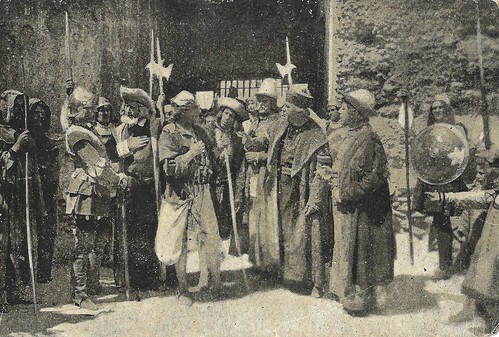
Spanish collector card by Empresa Cinematografica Barcelona for Chocolate Mundial, no. A-3. Photo: Argos P.C. / Films Cinematographiques. Georges Wague on the left as Christopher Columbus in La vida de Cristóbal Colón / La vie de Christophe Colomb (Gérard Bourgeois, 1916). Caption: After many sailings, Columbus' boat is attacked by pirates and he narrowly escapes. Fishermen bring him to the port of Lisbon, where friendly merchants bring him to his brother Bartholomew, a cartographist, who houses him and gives him work.
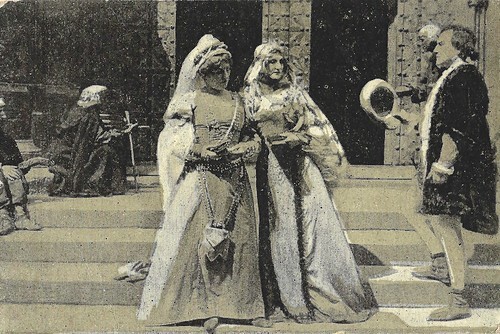
Spanish collector card by Empresa Cinematografica Barcelona for Chocolate Mundial, no. A-4. Photo: Argos P.C. / Films Cinematographiques. Georges Wague on the right as Christopher Columbus in La vida de Cristóbal Colón / La vie de Christophe Colomb (Gérard Bourgeois, 1916). Columbus meets for the first time his future wife Felipa de Perestrello (Nadette Darson) and her mother.
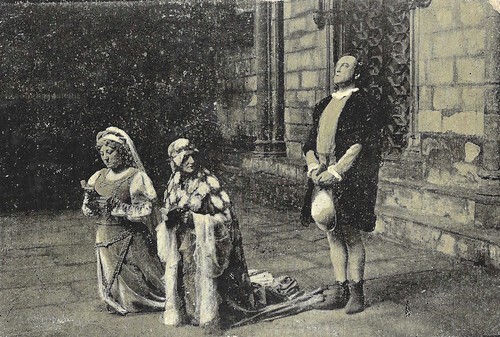
Spanish collector card by Empresa Cinematografica Barcelona for Chocolate Mundial, no. A-5. Photo: Argos P.C. / Films Cinematographiques. Georges Wague as Columbus on the right and Nadette Darson as Felipa in the middle in La vida de Cristóbal Colón / La vie de Christophe Colomb (Gérard Bourgeois, 1916).
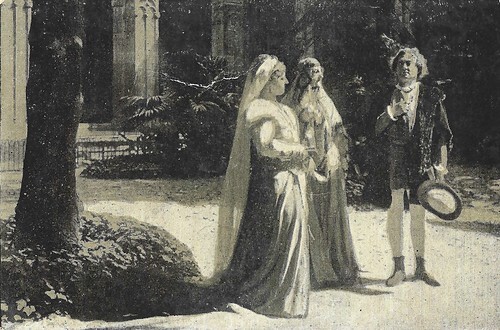
Spanish collector card by Empresa Cinematografica Barcelona for Chocolate Mundial, no. A-6. Photo: Argos P.C. / Films Cinematographiques. Georges Wague on the right as Christopher Columbus and Nadette Darson as Felipa in the middle in La vida de Cristóbal Colón / La vie de Christophe Colomb (Gérard Bourgeois, 1916).
The most expensive film made in Spain until then
La vida de Cristóbal Colón / La vie de Christophe Colomb, known under many different titles, including Vida de Cristóbal Colón y su descubrimiento de América, Christophe Colomb and the English title The Life of Christopher Columbus, is a remarkable international co-production, made in the middle of the First World War.
In 1916, the Spanish company Argos Films of José Carreras, together with the French company Films Cinématographiques, embarked on what was claimed to be the most expensive film made in Spain until then. According to advertisements at the time, the film exceeded a cost of one million pesetas and drew on the participation of more than 5,000 extras. It was a full-length feature film of 102 minutes.
The French director, Gerard Bourgeois was a renowned filmmaker and student of Victorin Jasset. He had worked at Eclair and Pathé on films dealing with social issues. The film’s French producer, Charles Drossner, arrived in Barcelona with a photographer, Edouard Renaul, and a cast of highly popular actors that featured Georges Wague (Christopher Columbus), Léontine Massart (Queen Isabella), Marcel Verdier (King Ferdinand), and others. In addition, the film counted on regular faces from the Barcelona cinema, such as Francesc Tressols and Enric López. Catalan participation included the fine work of the photographers Ramón de Baños and Josep M. Maristany, art director Adrià Gual, the sets of Salvador Alarma and props of Ramón Borrell, as well as the production tasks taken on by Llorenç Mata, one of the founders of the studio Barcinógrafo.
Depicted in a prologue and five episodes are different periods of Columbus's life, from his childhood and his financial relationship with the Castilian Kings, to the opposition and even indignities he suffered from enemies and those prejudiced against the idea of a New World, until his death. Filming took six months and was complicated. Nobody had any experience with this kind of large-scale co-production. Scenes were shot in Barcelona, Granada and other Spanish cities, making use of the real settings where the narrated events were supposed to have taken place.
The film was made in two parts, released in France as La Vie de Christophe Colomb and La Découverte de l'Amérique. In France, the second part of the film was only first released in 1919, while the first already had been shown in 1916. In Spain, the premiere, which was held at the Salón Cataluña in Barcelona with an orchestra of 15 musicians on 26 May 1917, was hailed as one of the great events in Spanish cinema. The Empresa Cinematografica Barcelona printed 30 mini cards with film stills in two series for Chocolate Mundial. In this post, eight of these cards of the first series are included.
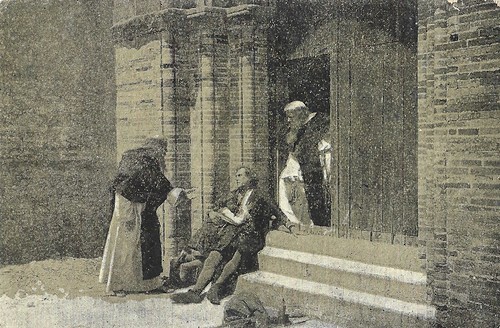
Spanish collector card by Empresa Cinematografica Barcelona for Chocolate Mundial, no. A-9. Photo: Argos P.C. / Films Cinematographiques. Scene from La vida de Cristóbal Colón / La vie de Christophe Colomb (Gérard Bourgeois, 1916), starring Georges Wague as Columbus. Caption: Months after his greatest deception [his rejection by King Juan II of Portugal], Columbus' wife Felipa dies, and he flees Portugal for Spain, with his young son Diego. Here he is welcomed at the Monastery of Rabida by Father Perez (Donnelly), to whom he tells all about his dreams, fears, and misery. Father Perez, enthusiastic about his plans, introduces him to the Castilian Court.
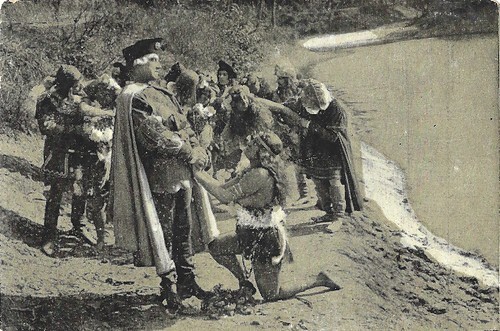
Spanish collector card by Empresa Cinematografica Barcelona for Chocolate Mundial, no. A-10. Photo: Argos P.C. / Films Cinematographiques. Scene from La vida de Cristóbal Colón / La vie de Christophe Colomb (Gérard Bourgeois, 1916), starring Georges Wague as Columbus.

Spanish collector card by Empresa Cinematografica Barcelona for Chocolate Mundial, no. A-11. Photo: Argos P.C. / Films Cinematographiques. Scene from La vida de Cristóbal Colón / La vie de Christophe Colomb (Gérard Bourgeois, 1916), starring Georges Wague . Plot: The jealous commander of the island, Pedro Margarit, incites hatred against the explorers by the local inhabitants, which eventually ruins Columbus.
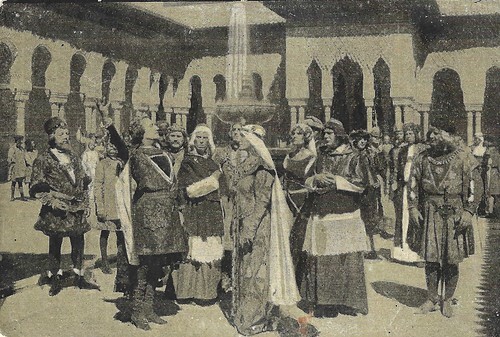
Spanish collector card by Empresa Cinematografica Barcelona for Chocolate Mundial, no. A-12. Photo: Argos P.C. / Films Cinematographiques. Scene from La vida de Cristóbal Colón / La vie de Christophe Colomb (Gérard Bourgeois, 1916), starring Georges Wague (Columbus) and Léontine Massart (Queen Isabella). Caption: Soon after the conquering of Granada, Columbus meets the Catholic Royal Couple. While Ferdinand of Aragon is a practical man and doesn't care about theory or ideals, Queen Isabella is inclined to help Columbus' visions, feeling her generosity may also offer new stars to her crown. This card shows the actors at the Alhambra in Granada.
Sources: Universitat de Barcelona, Cine-Ressources (French), Europeana and IMDb. For the full film, see European Film Gateway.

Spanish collector card by Empresa Cinematografica Barcelona for Chocolate Mundial, no. A-3. Photo: Argos P.C. / Films Cinematographiques. Georges Wague on the left as Christopher Columbus in La vida de Cristóbal Colón / La vie de Christophe Colomb (Gérard Bourgeois, 1916). Caption: After many sailings, Columbus' boat is attacked by pirates and he narrowly escapes. Fishermen bring him to the port of Lisbon, where friendly merchants bring him to his brother Bartholomew, a cartographist, who houses him and gives him work.

Spanish collector card by Empresa Cinematografica Barcelona for Chocolate Mundial, no. A-4. Photo: Argos P.C. / Films Cinematographiques. Georges Wague on the right as Christopher Columbus in La vida de Cristóbal Colón / La vie de Christophe Colomb (Gérard Bourgeois, 1916). Columbus meets for the first time his future wife Felipa de Perestrello (Nadette Darson) and her mother.

Spanish collector card by Empresa Cinematografica Barcelona for Chocolate Mundial, no. A-5. Photo: Argos P.C. / Films Cinematographiques. Georges Wague as Columbus on the right and Nadette Darson as Felipa in the middle in La vida de Cristóbal Colón / La vie de Christophe Colomb (Gérard Bourgeois, 1916).

Spanish collector card by Empresa Cinematografica Barcelona for Chocolate Mundial, no. A-6. Photo: Argos P.C. / Films Cinematographiques. Georges Wague on the right as Christopher Columbus and Nadette Darson as Felipa in the middle in La vida de Cristóbal Colón / La vie de Christophe Colomb (Gérard Bourgeois, 1916).
The most expensive film made in Spain until then
La vida de Cristóbal Colón / La vie de Christophe Colomb, known under many different titles, including Vida de Cristóbal Colón y su descubrimiento de América, Christophe Colomb and the English title The Life of Christopher Columbus, is a remarkable international co-production, made in the middle of the First World War.
In 1916, the Spanish company Argos Films of José Carreras, together with the French company Films Cinématographiques, embarked on what was claimed to be the most expensive film made in Spain until then. According to advertisements at the time, the film exceeded a cost of one million pesetas and drew on the participation of more than 5,000 extras. It was a full-length feature film of 102 minutes.
The French director, Gerard Bourgeois was a renowned filmmaker and student of Victorin Jasset. He had worked at Eclair and Pathé on films dealing with social issues. The film’s French producer, Charles Drossner, arrived in Barcelona with a photographer, Edouard Renaul, and a cast of highly popular actors that featured Georges Wague (Christopher Columbus), Léontine Massart (Queen Isabella), Marcel Verdier (King Ferdinand), and others. In addition, the film counted on regular faces from the Barcelona cinema, such as Francesc Tressols and Enric López. Catalan participation included the fine work of the photographers Ramón de Baños and Josep M. Maristany, art director Adrià Gual, the sets of Salvador Alarma and props of Ramón Borrell, as well as the production tasks taken on by Llorenç Mata, one of the founders of the studio Barcinógrafo.
Depicted in a prologue and five episodes are different periods of Columbus's life, from his childhood and his financial relationship with the Castilian Kings, to the opposition and even indignities he suffered from enemies and those prejudiced against the idea of a New World, until his death. Filming took six months and was complicated. Nobody had any experience with this kind of large-scale co-production. Scenes were shot in Barcelona, Granada and other Spanish cities, making use of the real settings where the narrated events were supposed to have taken place.
The film was made in two parts, released in France as La Vie de Christophe Colomb and La Découverte de l'Amérique. In France, the second part of the film was only first released in 1919, while the first already had been shown in 1916. In Spain, the premiere, which was held at the Salón Cataluña in Barcelona with an orchestra of 15 musicians on 26 May 1917, was hailed as one of the great events in Spanish cinema. The Empresa Cinematografica Barcelona printed 30 mini cards with film stills in two series for Chocolate Mundial. In this post, eight of these cards of the first series are included.

Spanish collector card by Empresa Cinematografica Barcelona for Chocolate Mundial, no. A-9. Photo: Argos P.C. / Films Cinematographiques. Scene from La vida de Cristóbal Colón / La vie de Christophe Colomb (Gérard Bourgeois, 1916), starring Georges Wague as Columbus. Caption: Months after his greatest deception [his rejection by King Juan II of Portugal], Columbus' wife Felipa dies, and he flees Portugal for Spain, with his young son Diego. Here he is welcomed at the Monastery of Rabida by Father Perez (Donnelly), to whom he tells all about his dreams, fears, and misery. Father Perez, enthusiastic about his plans, introduces him to the Castilian Court.

Spanish collector card by Empresa Cinematografica Barcelona for Chocolate Mundial, no. A-10. Photo: Argos P.C. / Films Cinematographiques. Scene from La vida de Cristóbal Colón / La vie de Christophe Colomb (Gérard Bourgeois, 1916), starring Georges Wague as Columbus.

Spanish collector card by Empresa Cinematografica Barcelona for Chocolate Mundial, no. A-11. Photo: Argos P.C. / Films Cinematographiques. Scene from La vida de Cristóbal Colón / La vie de Christophe Colomb (Gérard Bourgeois, 1916), starring Georges Wague . Plot: The jealous commander of the island, Pedro Margarit, incites hatred against the explorers by the local inhabitants, which eventually ruins Columbus.

Spanish collector card by Empresa Cinematografica Barcelona for Chocolate Mundial, no. A-12. Photo: Argos P.C. / Films Cinematographiques. Scene from La vida de Cristóbal Colón / La vie de Christophe Colomb (Gérard Bourgeois, 1916), starring Georges Wague (Columbus) and Léontine Massart (Queen Isabella). Caption: Soon after the conquering of Granada, Columbus meets the Catholic Royal Couple. While Ferdinand of Aragon is a practical man and doesn't care about theory or ideals, Queen Isabella is inclined to help Columbus' visions, feeling her generosity may also offer new stars to her crown. This card shows the actors at the Alhambra in Granada.
Sources: Universitat de Barcelona, Cine-Ressources (French), Europeana and IMDb. For the full film, see European Film Gateway.
Published on August 04, 2025 22:00
La vida de Cristóbal Colon (1916)
La vida de Cristóbal Colon/ La vie de Christophe Colomb (Gérard Bourgeois, 1916) was a Franco-Spanish production by Argos P.C. in Spain and Films Cinematographiques in France. The early silent film chronicles the life of Christopher Columbus. The stars were Georges Wague as the Italian-born explorer, Jean Garat as Bartholomew Columbus and Léontine Massart as Queen Isabella. The script was written by Charles Jean Drossner and the cinematography was done by Edouard Renault, Ramón de Baños, and José María Maristany. For this post, Ivo Blom found eight vintage Spanish collector cards of the film.

Spanish collector card by Empresa Cinematografica Barcelona for Chocolate Mundial, no. A-3. Photo: Argos P.C. / Films Cinematographiques. Georges Wague on the left as Christopher Columbus in La vida de Cristóbal Colon / La vie de Christophe Colomb (Gérard Bourgeois, 1916). Caption: After many sailings, Columbus' boat is attacked by pirates and he narrowly escapes. Fishermen bring him to the port of Lisbon, where friendly merchants bring him to his brother Bartholomew, a cartographist, who houses him and gives him work.

Spanish collector card by Empresa Cinematografica Barcelona for Chocolate Mundial, no. A-4. Photo: Argos P.C. / Films Cinematographiques. Georges Wague on the right as Christopher Columbus in La vida de Cristóbal Colon / La vie de Christophe Colomb (Gérard Bourgeois, 1916). Columbus meets for the first time his future wife Felipa de Perestrello (Nadette Darson) and her mother.

Spanish collector card by Empresa Cinematografica Barcelona for Chocolate Mundial, no. A-5. Photo: Argos P.C. / Films Cinematographiques. Georges Wague as Columbus on the right and Nadette Darson as Felipa in the middle in La vida de Cristóbal Colon / La vie de Christophe Colomb (Gérard Bourgeois, 1916).

Spanish collector card by Empresa Cinematografica Barcelona for Chocolate Mundial, no. A-6. Photo: Argos P.C. / Films Cinematographiques. Georges Wague on the right as Christopher Columbus and Nadette Darson as Felipa in the middle in La vida de Cristóbal Colon / La vie de Christophe Colomb (Gérard Bourgeois, 1916).
The most expensive film made in Spain until then
La vida de Cristóbal Colon / La vie de Christophe Colomb, known under many different titles, including Vida de Cristóbal Colón y su descubrimiento de América, Christophe Colomb and the English title The Life of Christopher Columbus, is a remarkable international co-production, made in the middle of the First World War.
In 1916, the Spanish company Argos Films of José Carreras, together with the French company Films Cinématographiques, embarked on what was claimed to be the most expensive film made in Spain until then. According to advertisements at the time, the film exceeded a cost of one million pesetas and drew on the participation of more than 5,000 extras. It was a full-length feature film of 102 minutes.
The French director, Gerard Bourgeois was a renowned filmmaker and student of Victorin Jasset. He had worked at Eclair and Pathé on films dealing with social issues. The film’s French producer, Charles Drossner, arrived in Barcelona with a photographer, Edouard Renaul, and a cast of highly popular actors that featured Georges Wague (Christopher Columbus), Léontine Massart (Queen Isabella), Marcel Verdier (King Ferdinand), and others. In addition, the film counted on regular faces from the Barcelona cinema, such as Francesc Tressols and Enric López. Catalan participation included the fine work of the photographers Ramón de Baños and Josep M. Maristany, art director Adrià Gual, the sets of Salvador Alarma and props of Ramón Borrell, as well as the production tasks taken on by Llorenç Mata, one of the founders of the studio Barcinógrafo.
Depicted in a prologue and five episodes are different periods of Columbus's life, from his childhood and his financial relationship with the Castilian Kings, to the opposition and even indignities he suffered from enemies and those prejudiced against the idea of a New World, until his death. Filming took six months and was complicated. Nobody had any experience with this kind of large-scale co-production. Scenes were shot in Barcelona, Granada and other Spanish cities, making use of the real settings where the narrated events were supposed to have taken place.
The film was made in two parts, released in France as La Vie de Christophe Colomb and La Découverte de l'Amérique. In France, the second part of the film was only first released in 1919, while the first already had been shown in 1916. In Spain, the premiere, which was held at the Salón Cataluña in Barcelona with an orchestra of 15 musicians on 26 May 1917, was hailed as one of the great events in Spanish cinema. The Empresa Cinematografica Barcelona printed 30 mini cards with film stills in two series for Chocolate Mundial. In this post, eight of these cards of the first series are included.

Spanish collector card by Empresa Cinematografica Barcelona for Chocolate Mundial, no. A-9. Photo: Argos P.C. / Films Cinematographiques. Scene from La vida de Cristóbal Colon / La vie de Christophe Colomb (Gérard Bourgeois, 1916), starring Georges Wague as Columbus. Caption: Months after his greatest deception [his rejection by King Juan II of Portugal], Columbus' wife Felipa dies, and he flees Portugal for Spain, with his young son Diego. Here he is welcomed at the Monastery of Rabida by Father Perez (Donnelly), to whom he tells all about his dreams, fears, and misery. Father Perez, enthusiastic about his plans, introduces him to the Castilian Court.

Spanish collector card by Empresa Cinematografica Barcelona for Chocolate Mundial, no. A-10. Photo: Argos P.C. / Films Cinematographiques. Scene from La vida de Cristóbal Colon / La vie de Christophe Colomb (Gérard Bourgeois, 1916), starring Georges Wague as Columbus.

Spanish collector card by Empresa Cinematografica Barcelona for Chocolate Mundial, no. A-11. Photo: Argos P.C. / Films Cinematographiques. Scene from La vida de Cristóbal Colon / La vie de Christophe Colomb (Gérard Bourgeois, 1916), starring Georges Wague . Plot: The jealous commander of the island, Pedro Margarit, incites hatred against the explorers by the local inhabitants, which eventually ruins Columbus.

Spanish collector card by Empresa Cinematografica Barcelona for Chocolate Mundial, no. A-12. Photo: Argos P.C. / Films Cinematographiques. Scene from La vida de Cristóbal Colon / La vie de Christophe Colomb (Gérard Bourgeois, 1916), starring Georges Wague (Columbus) and Léontine Massart (Queen Isabella). Caption: Soon after the conquering of Granada, Columbus meets the Catholic Royal Couple. While Ferdinand of Aragon is a practical man and doesn't care about theory or ideals, Queen Isabella is inclined to help Columbus' visions, feeling her generosity may also offer new stars to her crown. This card shows the actors at the Alhambra in Granada.
Sources: Universitat de Barcelona, Cine-Ressources (French), Europeana and IMDb. For the full film, see European Film Gateway.

Spanish collector card by Empresa Cinematografica Barcelona for Chocolate Mundial, no. A-3. Photo: Argos P.C. / Films Cinematographiques. Georges Wague on the left as Christopher Columbus in La vida de Cristóbal Colon / La vie de Christophe Colomb (Gérard Bourgeois, 1916). Caption: After many sailings, Columbus' boat is attacked by pirates and he narrowly escapes. Fishermen bring him to the port of Lisbon, where friendly merchants bring him to his brother Bartholomew, a cartographist, who houses him and gives him work.

Spanish collector card by Empresa Cinematografica Barcelona for Chocolate Mundial, no. A-4. Photo: Argos P.C. / Films Cinematographiques. Georges Wague on the right as Christopher Columbus in La vida de Cristóbal Colon / La vie de Christophe Colomb (Gérard Bourgeois, 1916). Columbus meets for the first time his future wife Felipa de Perestrello (Nadette Darson) and her mother.

Spanish collector card by Empresa Cinematografica Barcelona for Chocolate Mundial, no. A-5. Photo: Argos P.C. / Films Cinematographiques. Georges Wague as Columbus on the right and Nadette Darson as Felipa in the middle in La vida de Cristóbal Colon / La vie de Christophe Colomb (Gérard Bourgeois, 1916).

Spanish collector card by Empresa Cinematografica Barcelona for Chocolate Mundial, no. A-6. Photo: Argos P.C. / Films Cinematographiques. Georges Wague on the right as Christopher Columbus and Nadette Darson as Felipa in the middle in La vida de Cristóbal Colon / La vie de Christophe Colomb (Gérard Bourgeois, 1916).
The most expensive film made in Spain until then
La vida de Cristóbal Colon / La vie de Christophe Colomb, known under many different titles, including Vida de Cristóbal Colón y su descubrimiento de América, Christophe Colomb and the English title The Life of Christopher Columbus, is a remarkable international co-production, made in the middle of the First World War.
In 1916, the Spanish company Argos Films of José Carreras, together with the French company Films Cinématographiques, embarked on what was claimed to be the most expensive film made in Spain until then. According to advertisements at the time, the film exceeded a cost of one million pesetas and drew on the participation of more than 5,000 extras. It was a full-length feature film of 102 minutes.
The French director, Gerard Bourgeois was a renowned filmmaker and student of Victorin Jasset. He had worked at Eclair and Pathé on films dealing with social issues. The film’s French producer, Charles Drossner, arrived in Barcelona with a photographer, Edouard Renaul, and a cast of highly popular actors that featured Georges Wague (Christopher Columbus), Léontine Massart (Queen Isabella), Marcel Verdier (King Ferdinand), and others. In addition, the film counted on regular faces from the Barcelona cinema, such as Francesc Tressols and Enric López. Catalan participation included the fine work of the photographers Ramón de Baños and Josep M. Maristany, art director Adrià Gual, the sets of Salvador Alarma and props of Ramón Borrell, as well as the production tasks taken on by Llorenç Mata, one of the founders of the studio Barcinógrafo.
Depicted in a prologue and five episodes are different periods of Columbus's life, from his childhood and his financial relationship with the Castilian Kings, to the opposition and even indignities he suffered from enemies and those prejudiced against the idea of a New World, until his death. Filming took six months and was complicated. Nobody had any experience with this kind of large-scale co-production. Scenes were shot in Barcelona, Granada and other Spanish cities, making use of the real settings where the narrated events were supposed to have taken place.
The film was made in two parts, released in France as La Vie de Christophe Colomb and La Découverte de l'Amérique. In France, the second part of the film was only first released in 1919, while the first already had been shown in 1916. In Spain, the premiere, which was held at the Salón Cataluña in Barcelona with an orchestra of 15 musicians on 26 May 1917, was hailed as one of the great events in Spanish cinema. The Empresa Cinematografica Barcelona printed 30 mini cards with film stills in two series for Chocolate Mundial. In this post, eight of these cards of the first series are included.

Spanish collector card by Empresa Cinematografica Barcelona for Chocolate Mundial, no. A-9. Photo: Argos P.C. / Films Cinematographiques. Scene from La vida de Cristóbal Colon / La vie de Christophe Colomb (Gérard Bourgeois, 1916), starring Georges Wague as Columbus. Caption: Months after his greatest deception [his rejection by King Juan II of Portugal], Columbus' wife Felipa dies, and he flees Portugal for Spain, with his young son Diego. Here he is welcomed at the Monastery of Rabida by Father Perez (Donnelly), to whom he tells all about his dreams, fears, and misery. Father Perez, enthusiastic about his plans, introduces him to the Castilian Court.

Spanish collector card by Empresa Cinematografica Barcelona for Chocolate Mundial, no. A-10. Photo: Argos P.C. / Films Cinematographiques. Scene from La vida de Cristóbal Colon / La vie de Christophe Colomb (Gérard Bourgeois, 1916), starring Georges Wague as Columbus.

Spanish collector card by Empresa Cinematografica Barcelona for Chocolate Mundial, no. A-11. Photo: Argos P.C. / Films Cinematographiques. Scene from La vida de Cristóbal Colon / La vie de Christophe Colomb (Gérard Bourgeois, 1916), starring Georges Wague . Plot: The jealous commander of the island, Pedro Margarit, incites hatred against the explorers by the local inhabitants, which eventually ruins Columbus.

Spanish collector card by Empresa Cinematografica Barcelona for Chocolate Mundial, no. A-12. Photo: Argos P.C. / Films Cinematographiques. Scene from La vida de Cristóbal Colon / La vie de Christophe Colomb (Gérard Bourgeois, 1916), starring Georges Wague (Columbus) and Léontine Massart (Queen Isabella). Caption: Soon after the conquering of Granada, Columbus meets the Catholic Royal Couple. While Ferdinand of Aragon is a practical man and doesn't care about theory or ideals, Queen Isabella is inclined to help Columbus' visions, feeling her generosity may also offer new stars to her crown. This card shows the actors at the Alhambra in Granada.
Sources: Universitat de Barcelona, Cine-Ressources (French), Europeana and IMDb. For the full film, see European Film Gateway.
Published on August 04, 2025 22:00
August 3, 2025
George Nader
Ruggedly handsome American actor George Nader (1921-2002) was a Universal star of second features in the 1950s. Was the muscular beefcake star then sacrificed to the tabloids to save Rock Hudson's heterosexual reputation? During the 1960s, Nader’s career had a second life in the European cinema as secret agent Jerry Cotton.
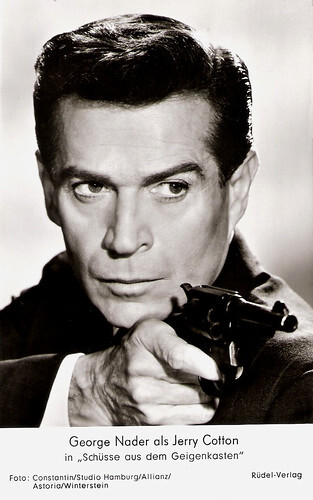
German postcard by Franz Josef Rüdel, Filmpostkartenverlag, Hamburg, no. 4250. Photo: Constantin / Studio Hamburg / Allianz / Astoria / Winterstein. George Nader as Jerry Cotton in Schüsse aus dem Geigenkasten / Operation Hurricane: Friday Noon (Fritz Umgelter, 1965).
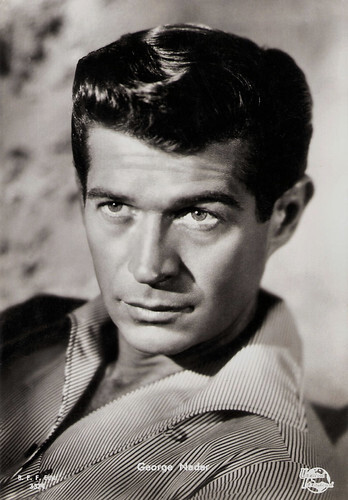
Italian postcard by B.F.F. Edit., no. 3329. Photo: Universal International.

Spanish postcard by F.A.G., no. 440. Photo: Universal. George Nader and Virginia Mayo in Congo Crossing (Joseph Pevney, 1956).

West German postcard by Rüdel-Verlag, Hamburg-Bergedorf. Photo: Constantin / Allianz / Lilo. George Nader as Jerry Cotton in Mordnacht in Manhattan / Manhattan Night of Murder (Harald Philipp, 1965).
Tall and muscular
George Nader was born in Pasadena, California, USA in 1921 (1932 according to some sources). He was the second son of Alice (née Scott) and George G. Nader, vice-president of a grocery chain. During World War II, he served in the US Navy as a communications officer in the Pacific Theatre of Operations. After the war, he earned his Bachelor of Arts in theatre arts at Occidental College and appeared in productions at the Pasadena Playhouse.
In 1947, he met Mark Miller, who had one of the lead roles in a Pasadena Playhouse production of 'Oh, Susannah!' Nader was in the chorus. The two fell in love and established a household together. Miller had intended to go to New York to study opera, but abandoned his plans to stay in California and help Nader launch his career.
Nader got small parts in the Western Rustlers on Horseback (Fred C. Brannon, 1950) and other B-movies. He got the lead role as Roy, the hero who saves the world from the clutches of ‘Ro-man’ in the low-budget 3D thriller Robot Monster (Phil Tucker, 1953). The film, shot in only four days for a mere sixteen thousand dollars, took in over a million dollars in its first run. In the 1980s, the Medved brothers listed it among the ‘50 worst films of all time,’ and it became a cult classic.
The tall and muscular Nader also had a sonorous voice and was offered a contract by Universal Pictures. He usually played parts that emphasised his ‘beefcake’ and he frequently appeared in swimsuits with his chest hair intact. In the mid-1950s, he played in several popular films, like the Western Four Guns to the Border (Richard Carlson, 1954) with Rory Calhoun , the crime drama Six Bridges to Cross (Joseph Pevney, 1955) opposite Tony Curtis , and the WWII actioner Away All Boats (Joseph Pevney, 1956), co-starring with Jeff Chandler . In 1954, he even won a Golden Globe Award for Most Promising Newcomer.
Unfortunately, the studio already had such good-looking and athletic stars as Rock Hudson and Tony Curtis on its roster. Nader often found himself being cast in such second features as the Film Noirs Appointment with a Shadow (Richard Carlson, 1957) and The Female Animal (Harry Keller, 1958), with Hedy Lamarr in her final appearance.
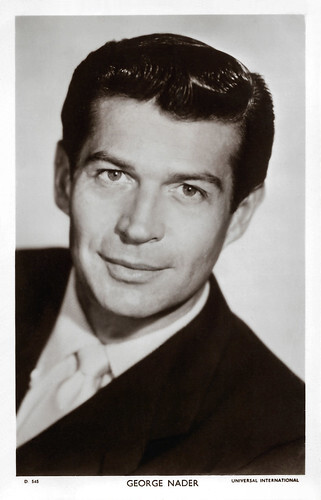
British postcard in the Picturegoer Series, Kondon, no. D 545. Photo: Universal International.

German postcard by WS-Druck, Wanne-Eickel, no. 440. Photo: Universal / Filmpress, Zürich.
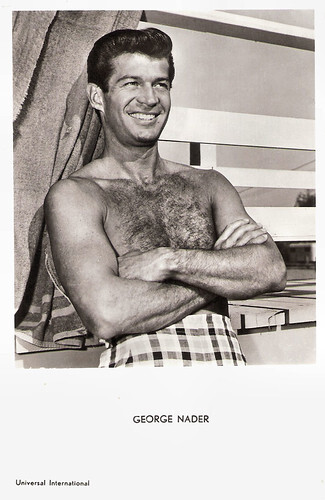
Vintage postcard, no. 30. Photo: Universal International.
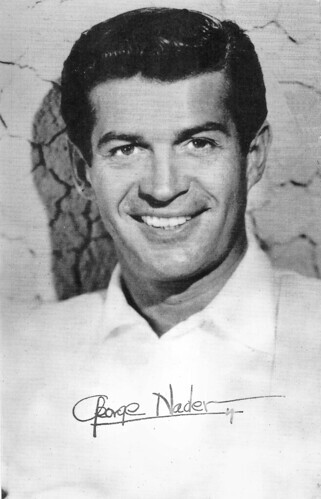
British postcard in the Celebrity Autograph Series by Celebrity Publishers Ltd., London, no. 224. Photo: Universal. Publicity still for Lady Godiva of Coventry (Arthur Lubin, 1955).
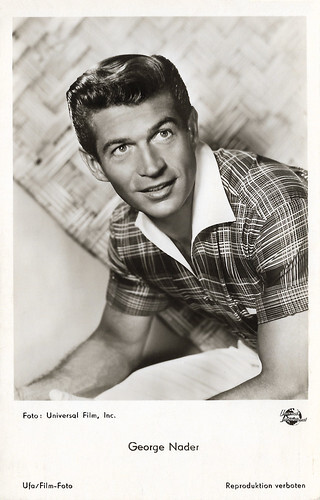
West German postcard by Ufa/Film-Foto, no. FR 3379. Photo: Universal Film, Inc. George Nader in The Unguarded Moment (Harry Keller, 1956).
G-Man Jerry Cotton
At the end of the 1950s, George Nader tried his hand at TV series, including the NBC adventure offering The Man and the Challenge (1959–1960) and Shannon (1961-1962), and then relocated to Europe. In Italy, he played musketeer D’Artagnan in Il colpo segreto di d'Artagnan / The Secret Mark of D'Artagnan (Siro Marcellini, 1962) with Magali Noël . In Portugal, he appeared in the Eurospy film Misión Lisboa / Mission Lisbon (Federico Aicardi, Tulio Demicheli, 1965).
But he found his biggest success in West Germany as G-man Jerry Cotton in the crime thriller Schüsse aus dem Geigenkasten / Operation Hurricane: Friday Noon (Fritz Umgelter, 1965). FBI agent Cotton was Germany's answer to James Bond. Murph-15 at IMDb : “In comparison to the Bond films, the Jerry Cotton movies are not as 'posh', but they are better stories. Operation Hurricane is the first and best of the series. The story is very interesting, with a few turns to keep the viewer going up to the end.”
In the following years, Nader enjoyed a modest career revival as Jerry Cotton in a series of such Eurospy films, and he became the number two most popular film star in Germany behind Lex Barker . His eight Cotton films include Die Rechnung - eiskalt serviert / Tip Not Included (Helmut Ashley, 1966), Der Tod im roten Jaguar / Death in the Red Jaguar (Harald Reinl, 1968), and finally Todesschüsse am Broadway / Broadway's Deadly Gold (Harald Reinl, 1969), with Heinz Weiss.
He returned to the US, where he played in a TV series and in a final film, the fantasy Beyond Atlantis (Eddie Romero, 1973) starring Patrick Wayne. Nader retired completely from acting in 1974 because an eye injury made him particularly sensitive to the bright lights of movie sets.
According to an interview with the German fanzine Splatting Image, his eye injury was the result of an accident during the production of the never-released movie Zigzag (Albert Zugsmith, 1963), when a blank pistol round exploded too early next to his eyes. Filming took place in the Philippines, and no adequate treatment was taken in time, resulting in the partial loss of his eyesight.
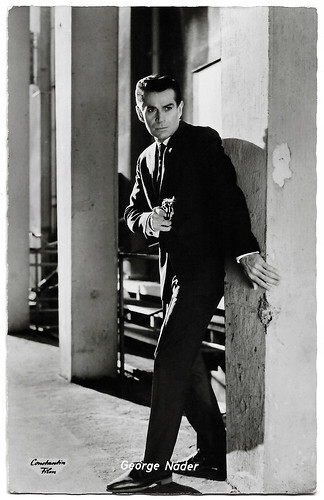
West German postcard by Kolibri-Verlag, Minden/Westf, no. 2317. Photo: Constantin Film / Studio Hamburg / Allianz / Astoria / Winterstein. George Nader as Jerry Cotton in Schüsse aus dem Geigenkasten / The Violin Case Murders (Fritz Umgelter, 1965).
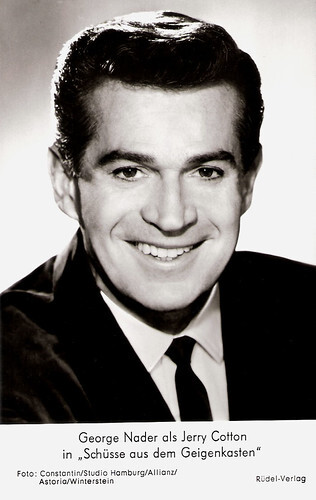
German postcard by Franz Josef Rüdel, Filmpostkartenverlag, Hamburg, no. 4249. Photo: Constantin / Studio Hamburg / Allianz / Astoria / Winterstein. George Nader as Jerry Cotton in Schüsse aus dem Geigenkasten / Operation Hurricane: Friday Noon (Fritz Umgelter, 1965).
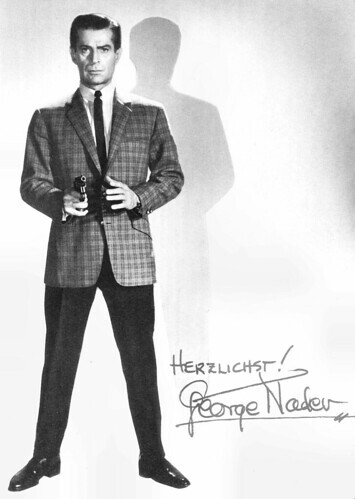
German promotion cardd. George Nader as Jerry Cotton in Um Null Uhr schnappt die Falle zu / 3-2-1 Countdown for Manhattan (Harald Philipp, 1966).
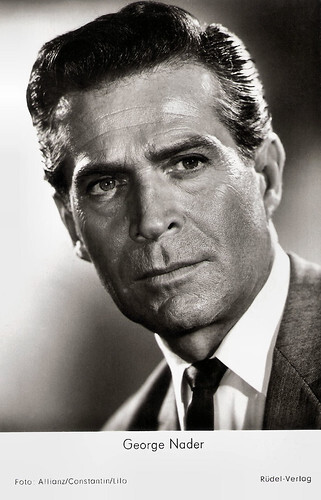
West German postcard by Rüdel Verlag, Hamburg Photo: Allianz / Constantin / Lilo. George Nader as Jerry Cotton in Die Rechnung - eiskalt serviert / Tip Not Included (Helmut Ashley, 1966).
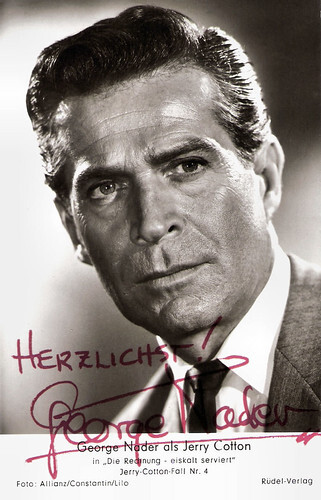
West German postcard by Rüdel-Verlag, Hamburg. Photo: Alianz / Coinstantin / Lilo. George Nader as Jerry Cotton in Die Rechnung - eiskalt serviert / Tip Not Included (Helmuth Ashley, 1966).
Forbidden love
George Nader turned to writing and dabbled in real estate. His Sci-Fi novel 'Chrome' (1978) told the story of forbidden love between a human and a robot, a metaphor about the place of gay men in society. Nader and Mark Miller collaborated on a second novel, 'The Perils of Paul'. It is about gays in Hollywood with names camouflaged and was published privately in hardcover in 1999.
In 1985, Nader was named one of the beneficiaries of Rock Hudson 's $27M estate when the star died of AIDS. Nader came out of the closet in 1986. Timothy Sexton at Yahoo! and IMDb both suggest that “Nader's career was sacrificed to (tabloid) Confidential to save Rock's much more lucrative heterosexual reputation".
In the mid-1950s, rumours about Nader's homosexuality had begun to surface. Nader and Miller were living together, but neither publicly acknowledged his homosexuality. Universal arranged for Nader to be seen on dates with beautiful stars as Martha Hyer and Piper Laurie . Linda Rapp at glbtq.com : “One publicist even went so far as to suggest that to avoid being outed by Confidential . Nader should marry and then get a divorce a few years later. A female secretary was willing to participate in the scheme. Nader and Miller discussed the possibility, but Nader could not bring himself to take part in such a sham.”
Nader said many years later in an interview: “We lived in fear of an exposé, or even one small remark, a veiled suggestion that someone was homosexual. Such a remark would have caused an earthquake at the studio. Every month, when Confidential came out, our stomachs began to turn. Which of us would be it?” However, such a tabloid article about Nader is not known ( Confidential did publish an outing story about Tab Hunter ). Nader and Hudson were lifelong friends, and Mark Miller was even Hudson's personal secretary for nearly 13 years.
In 2002, George Nader died at the Motion Picture and Television Hospital in Woodland Hills, Los Angeles, of cardiac pulmonary failure, pneumonia and multiple cerebral infarctions. He was 80 and was survived by Mark Miller, with whom he had spent 55 years, and by two cousins and his nephew, actor Michael Nader.

German postcard by ISV, no. E 38. Photo: Constantin. George Nader as Jerry Cotton in Die Rechnung - eiskalt serviert / Tip Not Included (Helmut Ashley, 1966).

West German postcard by Rüdel Verlag, Hamburg, no. 4829. Photo: Allianz / Constantin / Lilo. George Nader as Jerry Cotton in Dynamit in grüner Seide / Death and Diamonds (Harald Reinl, 1968).
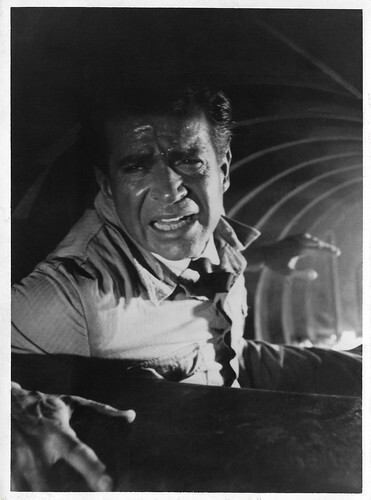
Spanish press photo by Empresa Alianza S.L.L., 1971. George Nader in Dynamit in grüner Seide / Death and Diamonds (Harald Reinl, 1968).

German postcard by Franz Josef Rüdel, Filmpostkartenverlag, Hamburg. Photo: Constantin. George Nader as Jerry Cotton in Der Tod im Roten Jaguar / Death in the Red Jaguar (Harald Reinl, 1968).
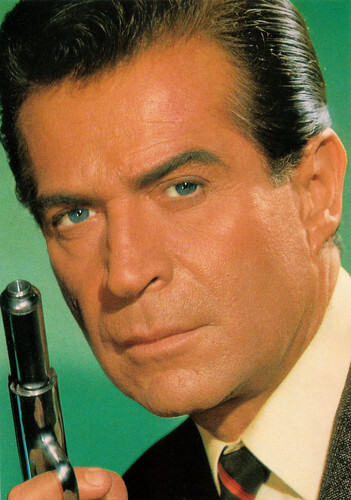
West German postcard by Ariola, Gütersloh. Nader made a record on which he performed the songs 'Lady Hello' and 'Frankie and Johnny'.
Sources: Linda Rapp (GLBTQ Archive), Army Archerd (Variety), Timothy Sexton (Yahoo! - Page now defunct), Strange Words, The New York Times, Wikipedia, and .

German postcard by Franz Josef Rüdel, Filmpostkartenverlag, Hamburg, no. 4250. Photo: Constantin / Studio Hamburg / Allianz / Astoria / Winterstein. George Nader as Jerry Cotton in Schüsse aus dem Geigenkasten / Operation Hurricane: Friday Noon (Fritz Umgelter, 1965).

Italian postcard by B.F.F. Edit., no. 3329. Photo: Universal International.

Spanish postcard by F.A.G., no. 440. Photo: Universal. George Nader and Virginia Mayo in Congo Crossing (Joseph Pevney, 1956).

West German postcard by Rüdel-Verlag, Hamburg-Bergedorf. Photo: Constantin / Allianz / Lilo. George Nader as Jerry Cotton in Mordnacht in Manhattan / Manhattan Night of Murder (Harald Philipp, 1965).
Tall and muscular
George Nader was born in Pasadena, California, USA in 1921 (1932 according to some sources). He was the second son of Alice (née Scott) and George G. Nader, vice-president of a grocery chain. During World War II, he served in the US Navy as a communications officer in the Pacific Theatre of Operations. After the war, he earned his Bachelor of Arts in theatre arts at Occidental College and appeared in productions at the Pasadena Playhouse.
In 1947, he met Mark Miller, who had one of the lead roles in a Pasadena Playhouse production of 'Oh, Susannah!' Nader was in the chorus. The two fell in love and established a household together. Miller had intended to go to New York to study opera, but abandoned his plans to stay in California and help Nader launch his career.
Nader got small parts in the Western Rustlers on Horseback (Fred C. Brannon, 1950) and other B-movies. He got the lead role as Roy, the hero who saves the world from the clutches of ‘Ro-man’ in the low-budget 3D thriller Robot Monster (Phil Tucker, 1953). The film, shot in only four days for a mere sixteen thousand dollars, took in over a million dollars in its first run. In the 1980s, the Medved brothers listed it among the ‘50 worst films of all time,’ and it became a cult classic.
The tall and muscular Nader also had a sonorous voice and was offered a contract by Universal Pictures. He usually played parts that emphasised his ‘beefcake’ and he frequently appeared in swimsuits with his chest hair intact. In the mid-1950s, he played in several popular films, like the Western Four Guns to the Border (Richard Carlson, 1954) with Rory Calhoun , the crime drama Six Bridges to Cross (Joseph Pevney, 1955) opposite Tony Curtis , and the WWII actioner Away All Boats (Joseph Pevney, 1956), co-starring with Jeff Chandler . In 1954, he even won a Golden Globe Award for Most Promising Newcomer.
Unfortunately, the studio already had such good-looking and athletic stars as Rock Hudson and Tony Curtis on its roster. Nader often found himself being cast in such second features as the Film Noirs Appointment with a Shadow (Richard Carlson, 1957) and The Female Animal (Harry Keller, 1958), with Hedy Lamarr in her final appearance.

British postcard in the Picturegoer Series, Kondon, no. D 545. Photo: Universal International.

German postcard by WS-Druck, Wanne-Eickel, no. 440. Photo: Universal / Filmpress, Zürich.

Vintage postcard, no. 30. Photo: Universal International.

British postcard in the Celebrity Autograph Series by Celebrity Publishers Ltd., London, no. 224. Photo: Universal. Publicity still for Lady Godiva of Coventry (Arthur Lubin, 1955).

West German postcard by Ufa/Film-Foto, no. FR 3379. Photo: Universal Film, Inc. George Nader in The Unguarded Moment (Harry Keller, 1956).
G-Man Jerry Cotton
At the end of the 1950s, George Nader tried his hand at TV series, including the NBC adventure offering The Man and the Challenge (1959–1960) and Shannon (1961-1962), and then relocated to Europe. In Italy, he played musketeer D’Artagnan in Il colpo segreto di d'Artagnan / The Secret Mark of D'Artagnan (Siro Marcellini, 1962) with Magali Noël . In Portugal, he appeared in the Eurospy film Misión Lisboa / Mission Lisbon (Federico Aicardi, Tulio Demicheli, 1965).
But he found his biggest success in West Germany as G-man Jerry Cotton in the crime thriller Schüsse aus dem Geigenkasten / Operation Hurricane: Friday Noon (Fritz Umgelter, 1965). FBI agent Cotton was Germany's answer to James Bond. Murph-15 at IMDb : “In comparison to the Bond films, the Jerry Cotton movies are not as 'posh', but they are better stories. Operation Hurricane is the first and best of the series. The story is very interesting, with a few turns to keep the viewer going up to the end.”
In the following years, Nader enjoyed a modest career revival as Jerry Cotton in a series of such Eurospy films, and he became the number two most popular film star in Germany behind Lex Barker . His eight Cotton films include Die Rechnung - eiskalt serviert / Tip Not Included (Helmut Ashley, 1966), Der Tod im roten Jaguar / Death in the Red Jaguar (Harald Reinl, 1968), and finally Todesschüsse am Broadway / Broadway's Deadly Gold (Harald Reinl, 1969), with Heinz Weiss.
He returned to the US, where he played in a TV series and in a final film, the fantasy Beyond Atlantis (Eddie Romero, 1973) starring Patrick Wayne. Nader retired completely from acting in 1974 because an eye injury made him particularly sensitive to the bright lights of movie sets.
According to an interview with the German fanzine Splatting Image, his eye injury was the result of an accident during the production of the never-released movie Zigzag (Albert Zugsmith, 1963), when a blank pistol round exploded too early next to his eyes. Filming took place in the Philippines, and no adequate treatment was taken in time, resulting in the partial loss of his eyesight.

West German postcard by Kolibri-Verlag, Minden/Westf, no. 2317. Photo: Constantin Film / Studio Hamburg / Allianz / Astoria / Winterstein. George Nader as Jerry Cotton in Schüsse aus dem Geigenkasten / The Violin Case Murders (Fritz Umgelter, 1965).

German postcard by Franz Josef Rüdel, Filmpostkartenverlag, Hamburg, no. 4249. Photo: Constantin / Studio Hamburg / Allianz / Astoria / Winterstein. George Nader as Jerry Cotton in Schüsse aus dem Geigenkasten / Operation Hurricane: Friday Noon (Fritz Umgelter, 1965).

German promotion cardd. George Nader as Jerry Cotton in Um Null Uhr schnappt die Falle zu / 3-2-1 Countdown for Manhattan (Harald Philipp, 1966).

West German postcard by Rüdel Verlag, Hamburg Photo: Allianz / Constantin / Lilo. George Nader as Jerry Cotton in Die Rechnung - eiskalt serviert / Tip Not Included (Helmut Ashley, 1966).

West German postcard by Rüdel-Verlag, Hamburg. Photo: Alianz / Coinstantin / Lilo. George Nader as Jerry Cotton in Die Rechnung - eiskalt serviert / Tip Not Included (Helmuth Ashley, 1966).
Forbidden love
George Nader turned to writing and dabbled in real estate. His Sci-Fi novel 'Chrome' (1978) told the story of forbidden love between a human and a robot, a metaphor about the place of gay men in society. Nader and Mark Miller collaborated on a second novel, 'The Perils of Paul'. It is about gays in Hollywood with names camouflaged and was published privately in hardcover in 1999.
In 1985, Nader was named one of the beneficiaries of Rock Hudson 's $27M estate when the star died of AIDS. Nader came out of the closet in 1986. Timothy Sexton at Yahoo! and IMDb both suggest that “Nader's career was sacrificed to (tabloid) Confidential to save Rock's much more lucrative heterosexual reputation".
In the mid-1950s, rumours about Nader's homosexuality had begun to surface. Nader and Miller were living together, but neither publicly acknowledged his homosexuality. Universal arranged for Nader to be seen on dates with beautiful stars as Martha Hyer and Piper Laurie . Linda Rapp at glbtq.com : “One publicist even went so far as to suggest that to avoid being outed by Confidential . Nader should marry and then get a divorce a few years later. A female secretary was willing to participate in the scheme. Nader and Miller discussed the possibility, but Nader could not bring himself to take part in such a sham.”
Nader said many years later in an interview: “We lived in fear of an exposé, or even one small remark, a veiled suggestion that someone was homosexual. Such a remark would have caused an earthquake at the studio. Every month, when Confidential came out, our stomachs began to turn. Which of us would be it?” However, such a tabloid article about Nader is not known ( Confidential did publish an outing story about Tab Hunter ). Nader and Hudson were lifelong friends, and Mark Miller was even Hudson's personal secretary for nearly 13 years.
In 2002, George Nader died at the Motion Picture and Television Hospital in Woodland Hills, Los Angeles, of cardiac pulmonary failure, pneumonia and multiple cerebral infarctions. He was 80 and was survived by Mark Miller, with whom he had spent 55 years, and by two cousins and his nephew, actor Michael Nader.

German postcard by ISV, no. E 38. Photo: Constantin. George Nader as Jerry Cotton in Die Rechnung - eiskalt serviert / Tip Not Included (Helmut Ashley, 1966).

West German postcard by Rüdel Verlag, Hamburg, no. 4829. Photo: Allianz / Constantin / Lilo. George Nader as Jerry Cotton in Dynamit in grüner Seide / Death and Diamonds (Harald Reinl, 1968).

Spanish press photo by Empresa Alianza S.L.L., 1971. George Nader in Dynamit in grüner Seide / Death and Diamonds (Harald Reinl, 1968).

German postcard by Franz Josef Rüdel, Filmpostkartenverlag, Hamburg. Photo: Constantin. George Nader as Jerry Cotton in Der Tod im Roten Jaguar / Death in the Red Jaguar (Harald Reinl, 1968).

West German postcard by Ariola, Gütersloh. Nader made a record on which he performed the songs 'Lady Hello' and 'Frankie and Johnny'.
Sources: Linda Rapp (GLBTQ Archive), Army Archerd (Variety), Timothy Sexton (Yahoo! - Page now defunct), Strange Words, The New York Times, Wikipedia, and .
Published on August 03, 2025 22:00
George Nader
Ruggedly handsome American actor George Nader (1921-2002) was a Universal star of second features in the 1950s. Was the muscular beefcake star then sacrificed to the tabloids to save Rock Hudson's heterosexual reputation? During the 1960s, Nader’s career had a second life in the European cinema as secret agent Jerry Cotton.

German postcard by Franz Josef Rüdel, Filmpostkartenverlag, Hamburg, no. 4250. Photo: Constantin / Studio Hamburg / Allianz / Astoria / Winterstein. George Nader as Jerry Cotton in Schüsse aus dem Geigenkasten / Operation Hurricane: Friday Noon (Fritz Umgelter, 1965).

Italian postcard by B.F.F. Edit., no. 3329. Photo: Universal International.

Spanish postcard by F.A.G., no. 440. Photo: Universal. George Nader and Virginia Mayo in Congo Crossing (Joseph Pevney, 1956).

West German postcard by Rüdel-Verlag, Hamburg-Bergedorf. Photo: Constantin / Allianz / Lilo. George Nader as Jerry Cotton in Mordnacht in Manhattan / Manhattan Night of Murder (Harald Philipp, 1965).
Tall and muscular
George Nader was born in Pasadena, California, USA in 1921 (1932 according to some sources). He was the second son of Alice (née Scott) and George G. Nader, vice-president of a grocery chain. During World War II, he served in the US Navy as a communications officer in the Pacific Theatre of Operations. After the war, he earned his Bachelor of Arts in theatre arts at Occidental College and appeared in productions at the Pasadena Playhouse.
In 1947, he met Mark Miller, who had one of the lead roles in a Pasadena Playhouse production of 'Oh, Susannah!' Nader was in the chorus. The two fell in love and established a household together. Miller had intended to go to New York to study opera, but abandoned his plans to stay in California and help Nader launch his career.
Nader got small parts in the Western Rustlers on Horseback (Fred C. Brannon, 1950) and other B-movies. He got the lead role as Roy, the hero who saves the world from the clutches of ‘Ro-man’ in the low-budget 3D thriller Robot Monster (Phil Tucker, 1953). The film, shot in only four days for a mere sixteen thousand dollars, took in over a million dollars in its first run. In the 1980s, the Medved brothers listed it among the ‘50 worst films of all time,’ and it became a cult classic.
The tall and muscular Nader also had a sonorous voice and was offered a contract by Universal Pictures. He usually played parts that emphasised his ‘beefcake’ and he frequently appeared in swimsuits with his chest hair intact. In the mid-1950s, he played in several popular films, like the Western Four Guns to the Border (Richard Carlson, 1954) with Rory Calhoun , the crime drama Six Bridges to Cross (Joseph Pevney, 1955) opposite Tony Curtis , and the WWII actioner Away All Boats (Joseph Pevney, 1956), co-starring with Jeff Chandler . In 1954, he even won a Golden Globe Award for Most Promising Newcomer.
Unfortunately, the studio already had such good-looking and athletic stars as Rock Hudson and Tony Curtis on its roster. Nader often found himself being cast in such second features as the Film Noirs Appointment with a Shadow (Richard Carlson, 1957) and The Female Animal (Harry Keller, 1958), with Hedy Lamarr in her final appearance.

British postcard in the Picturegoer Series, Kondon, no. D 545. Photo: Universal International.

German postcard by WS-Druck, Wanne-Eickel, no. 440. Photo: Universal / Filmpress, Zürich.

Vintage postcard, no. 30. Photo: Universal International.

British postcard in the Celebrity Autograph Series by Celebrity Publishers Ltd., London, no. 224. Photo: Universal. Publicity still for Lady Godiva of Coventry (Arthur Lubin, 1955).

West German postcard by Ufa/Film-Foto, no. FR 3379. Photo: Universal Film, Inc. George Nader in The Unguarded Moment (Harry Keller, 1956).
G-Man Jerry Cotton
At the end of the 1950s, George Nader tried his hand at TV series, including the NBC adventure offering The Man and the Challenge (1959–1960) and Shannon (1961-1962), and then relocated to Europe. In Italy, he played musketeer D’Artagnan in Il colpo segreto di d'Artagnan / The Secret Mark of D'Artagnan (Siro Marcellini, 1962) with Magali Noël . In Portugal, he appeared in the Eurospy film Misión Lisboa / Mission Lisbon (Federico Aicardi, Tulio Demicheli, 1965).
But he found his biggest success in West Germany as G-man Jerry Cotton in the crime thriller Schüsse aus dem Geigenkasten / Operation Hurricane: Friday Noon (Fritz Umgelter, 1965). FBI agent Cotton was Germany's answer to James Bond. Murph-15 at IMDb : “In comparison to the Bond films, the Jerry Cotton movies are not as 'posh', but they are better stories. Operation Hurricane is the first and best of the series. The story is very interesting, with a few turns to keep the viewer going up to the end.”
In the following years, Nader enjoyed a modest career revival as Jerry Cotton in a series of such Eurospy films, and he became the number two most popular film star in Germany behind Lex Barker . His eight Cotton films include Die Rechnung - eiskalt serviert / Tip Not Included (Helmut Ashley, 1966), Der Tod im roten Jaguar / Death in the Red Jaguar (Harald Reinl, 1968), and finally Todesschüsse am Broadway / Broadway's Deadly Gold (Harald Reinl, 1969), with Heinz Weiss.
He returned to the US, where he played in a TV series and in a final film, the fantasy Beyond Atlantis (Eddie Romero, 1973) starring Patrick Wayne. Nader retired completely from acting in 1974 because an eye injury made him particularly sensitive to the bright lights of movie sets.
According to an interview with the German fanzine Splatting Image, his eye injury was the result of an accident during the production of the never-released movie Zigzag (Albert Zugsmith, 1963), when a blank pistol round exploded too early next to his eyes. Filming took place in the Philippines, and no adequate treatment was taken in time, resulting in the partial loss of his eyesight.

West German postcard by Kolibri-Verlag, Minden/Westf, no. 2317. Photo: Constantin Film / Studio Hamburg / Allianz / Astoria / Winterstein. George Nader as Jerry Cotton in Schüsse aus dem Geigenkasten / The Violin Case Murders (Fritz Umgelter, 1965).

German postcard by Franz Josef Rüdel, Filmpostkartenverlag, Hamburg, no. 4249. Photo: Constantin / Studio Hamburg / Allianz / Astoria / Winterstein. George Nader as Jerry Cotton in Schüsse aus dem Geigenkasten / Operation Hurricane: Friday Noon (Fritz Umgelter, 1965).

German promotion cardd. George Nader as Jerry Cotton in Um Null Uhr schnappt die Falle zu / 3-2-1 Countdown for Manhattan (Harald Philipp, 1966).

West German postcard by Rüdel Verlag, Hamburg Photo: Allianz / Constantin / Lilo. George Nader as Jerry Cotton in Die Rechnung - eiskalt serviert / Tip Not Included (Helmut Ashley, 1966).

West German postcard by Rüdel-Verlag, Hamburg. Photo: Alianz / Coinstantin / Lilo. George Nader as Jerry Cotton in Die Rechnung - eiskalt serviert / Tip Not Included (Helmuth Ashley, 1966).
Forbidden love
George Nader turned to writing and dabbled in real estate. His Sci-Fi novel 'Chrome' (1978) told the story of forbidden love between a human and a robot, a metaphor about the place of gay men in society. Nader and Mark Miller collaborated on a second novel, 'The Perils of Paul'. It is about gays in Hollywood with names camouflaged and was published privately in hardcover in 1999.
In 1985, Nader was named one of the beneficiaries of Rock Hudson 's $27M estate when the star died of AIDS. Nader came out of the closet in 1986. Timothy Sexton at Yahoo! and IMDb both suggest that “Nader's career was sacrificed to (tabloid) Confidential to save Rock's much more lucrative heterosexual reputation".
In the mid-1950s, rumours about Nader's homosexuality had begun to surface. Nader and Miller were living together, but neither publicly acknowledged his homosexuality. Universal arranged for Nader to be seen on dates with beautiful stars as Martha Hyer and Piper Laurie . Linda Rapp at glbtq.com : “One publicist even went so far as to suggest that to avoid being outed by Confidential . Nader should marry and then get a divorce a few years later. A female secretary was willing to participate in the scheme. Nader and Miller discussed the possibility, but Nader could not bring himself to take part in such a sham.”
Nader said many years later in an interview: “We lived in fear of an exposé, or even one small remark, a veiled suggestion that someone was homosexual. Such a remark would have caused an earthquake at the studio. Every month, when Confidential came out, our stomachs began to turn. Which of us would be it?” However, such a tabloid article about Nader is not known ( Confidential did publish an outing story about Tab Hunter ). Nader and Hudson were lifelong friends, and Mark Miller was even Hudson's personal secretary for nearly 13 years.
In 2002, George Nader died at the Motion Picture and Television Hospital in Woodland Hills, Los Angeles, of cardiac pulmonary failure, pneumonia and multiple cerebral infarctions. He was 80 and was survived by Mark Miller, with whom he had spent 55 years, and by two cousins and his nephew, actor Michael Nader.

German postcard by ISV, no. E 38. Photo: Constantin. George Nader as Jerry Cotton in Die Rechnung - eiskalt serviert / Tip Not Included (Helmut Ashley, 1966).

West German postcard by Rüdel Verlag, Hamburg, no. 4829. Photo: Allianz / Constantin / Lilo. George Nader as Jerry Cotton in Dynamit in grüner Seide / Death and Diamonds (Harald Reinl, 1968).

Spanish press photo by Empresa Alianza S.L.L., 1971. George Nader in Dynamit in grüner Seide / Death and Diamonds (Harald Reinl, 1968).

German postcard by Franz Josef Rüdel, Filmpostkartenverlag, Hamburg. Photo: Constantin. George Nader as Jerry Cotton in Der Tod im Roten Jaguar / Death in the Red Jaguar (Harald Reinl, 1968).

West German postcard by Ariola, Gütersloh. Nader made a record on which he performed the songs 'Lady Hello' and 'Frankie and Johnny'.
Sources: Linda Rapp (GLBTQ Archive), Army Archerd (Variety), Timothy Sexton (Yahoo! - Page now defunct), Strange Words, The New York Times, Wikipedia, and .

German postcard by Franz Josef Rüdel, Filmpostkartenverlag, Hamburg, no. 4250. Photo: Constantin / Studio Hamburg / Allianz / Astoria / Winterstein. George Nader as Jerry Cotton in Schüsse aus dem Geigenkasten / Operation Hurricane: Friday Noon (Fritz Umgelter, 1965).

Italian postcard by B.F.F. Edit., no. 3329. Photo: Universal International.

Spanish postcard by F.A.G., no. 440. Photo: Universal. George Nader and Virginia Mayo in Congo Crossing (Joseph Pevney, 1956).

West German postcard by Rüdel-Verlag, Hamburg-Bergedorf. Photo: Constantin / Allianz / Lilo. George Nader as Jerry Cotton in Mordnacht in Manhattan / Manhattan Night of Murder (Harald Philipp, 1965).
Tall and muscular
George Nader was born in Pasadena, California, USA in 1921 (1932 according to some sources). He was the second son of Alice (née Scott) and George G. Nader, vice-president of a grocery chain. During World War II, he served in the US Navy as a communications officer in the Pacific Theatre of Operations. After the war, he earned his Bachelor of Arts in theatre arts at Occidental College and appeared in productions at the Pasadena Playhouse.
In 1947, he met Mark Miller, who had one of the lead roles in a Pasadena Playhouse production of 'Oh, Susannah!' Nader was in the chorus. The two fell in love and established a household together. Miller had intended to go to New York to study opera, but abandoned his plans to stay in California and help Nader launch his career.
Nader got small parts in the Western Rustlers on Horseback (Fred C. Brannon, 1950) and other B-movies. He got the lead role as Roy, the hero who saves the world from the clutches of ‘Ro-man’ in the low-budget 3D thriller Robot Monster (Phil Tucker, 1953). The film, shot in only four days for a mere sixteen thousand dollars, took in over a million dollars in its first run. In the 1980s, the Medved brothers listed it among the ‘50 worst films of all time,’ and it became a cult classic.
The tall and muscular Nader also had a sonorous voice and was offered a contract by Universal Pictures. He usually played parts that emphasised his ‘beefcake’ and he frequently appeared in swimsuits with his chest hair intact. In the mid-1950s, he played in several popular films, like the Western Four Guns to the Border (Richard Carlson, 1954) with Rory Calhoun , the crime drama Six Bridges to Cross (Joseph Pevney, 1955) opposite Tony Curtis , and the WWII actioner Away All Boats (Joseph Pevney, 1956), co-starring with Jeff Chandler . In 1954, he even won a Golden Globe Award for Most Promising Newcomer.
Unfortunately, the studio already had such good-looking and athletic stars as Rock Hudson and Tony Curtis on its roster. Nader often found himself being cast in such second features as the Film Noirs Appointment with a Shadow (Richard Carlson, 1957) and The Female Animal (Harry Keller, 1958), with Hedy Lamarr in her final appearance.

British postcard in the Picturegoer Series, Kondon, no. D 545. Photo: Universal International.

German postcard by WS-Druck, Wanne-Eickel, no. 440. Photo: Universal / Filmpress, Zürich.

Vintage postcard, no. 30. Photo: Universal International.

British postcard in the Celebrity Autograph Series by Celebrity Publishers Ltd., London, no. 224. Photo: Universal. Publicity still for Lady Godiva of Coventry (Arthur Lubin, 1955).

West German postcard by Ufa/Film-Foto, no. FR 3379. Photo: Universal Film, Inc. George Nader in The Unguarded Moment (Harry Keller, 1956).
G-Man Jerry Cotton
At the end of the 1950s, George Nader tried his hand at TV series, including the NBC adventure offering The Man and the Challenge (1959–1960) and Shannon (1961-1962), and then relocated to Europe. In Italy, he played musketeer D’Artagnan in Il colpo segreto di d'Artagnan / The Secret Mark of D'Artagnan (Siro Marcellini, 1962) with Magali Noël . In Portugal, he appeared in the Eurospy film Misión Lisboa / Mission Lisbon (Federico Aicardi, Tulio Demicheli, 1965).
But he found his biggest success in West Germany as G-man Jerry Cotton in the crime thriller Schüsse aus dem Geigenkasten / Operation Hurricane: Friday Noon (Fritz Umgelter, 1965). FBI agent Cotton was Germany's answer to James Bond. Murph-15 at IMDb : “In comparison to the Bond films, the Jerry Cotton movies are not as 'posh', but they are better stories. Operation Hurricane is the first and best of the series. The story is very interesting, with a few turns to keep the viewer going up to the end.”
In the following years, Nader enjoyed a modest career revival as Jerry Cotton in a series of such Eurospy films, and he became the number two most popular film star in Germany behind Lex Barker . His eight Cotton films include Die Rechnung - eiskalt serviert / Tip Not Included (Helmut Ashley, 1966), Der Tod im roten Jaguar / Death in the Red Jaguar (Harald Reinl, 1968), and finally Todesschüsse am Broadway / Broadway's Deadly Gold (Harald Reinl, 1969), with Heinz Weiss.
He returned to the US, where he played in a TV series and in a final film, the fantasy Beyond Atlantis (Eddie Romero, 1973) starring Patrick Wayne. Nader retired completely from acting in 1974 because an eye injury made him particularly sensitive to the bright lights of movie sets.
According to an interview with the German fanzine Splatting Image, his eye injury was the result of an accident during the production of the never-released movie Zigzag (Albert Zugsmith, 1963), when a blank pistol round exploded too early next to his eyes. Filming took place in the Philippines, and no adequate treatment was taken in time, resulting in the partial loss of his eyesight.

West German postcard by Kolibri-Verlag, Minden/Westf, no. 2317. Photo: Constantin Film / Studio Hamburg / Allianz / Astoria / Winterstein. George Nader as Jerry Cotton in Schüsse aus dem Geigenkasten / The Violin Case Murders (Fritz Umgelter, 1965).

German postcard by Franz Josef Rüdel, Filmpostkartenverlag, Hamburg, no. 4249. Photo: Constantin / Studio Hamburg / Allianz / Astoria / Winterstein. George Nader as Jerry Cotton in Schüsse aus dem Geigenkasten / Operation Hurricane: Friday Noon (Fritz Umgelter, 1965).

German promotion cardd. George Nader as Jerry Cotton in Um Null Uhr schnappt die Falle zu / 3-2-1 Countdown for Manhattan (Harald Philipp, 1966).

West German postcard by Rüdel Verlag, Hamburg Photo: Allianz / Constantin / Lilo. George Nader as Jerry Cotton in Die Rechnung - eiskalt serviert / Tip Not Included (Helmut Ashley, 1966).

West German postcard by Rüdel-Verlag, Hamburg. Photo: Alianz / Coinstantin / Lilo. George Nader as Jerry Cotton in Die Rechnung - eiskalt serviert / Tip Not Included (Helmuth Ashley, 1966).
Forbidden love
George Nader turned to writing and dabbled in real estate. His Sci-Fi novel 'Chrome' (1978) told the story of forbidden love between a human and a robot, a metaphor about the place of gay men in society. Nader and Mark Miller collaborated on a second novel, 'The Perils of Paul'. It is about gays in Hollywood with names camouflaged and was published privately in hardcover in 1999.
In 1985, Nader was named one of the beneficiaries of Rock Hudson 's $27M estate when the star died of AIDS. Nader came out of the closet in 1986. Timothy Sexton at Yahoo! and IMDb both suggest that “Nader's career was sacrificed to (tabloid) Confidential to save Rock's much more lucrative heterosexual reputation".
In the mid-1950s, rumours about Nader's homosexuality had begun to surface. Nader and Miller were living together, but neither publicly acknowledged his homosexuality. Universal arranged for Nader to be seen on dates with beautiful stars as Martha Hyer and Piper Laurie . Linda Rapp at glbtq.com : “One publicist even went so far as to suggest that to avoid being outed by Confidential . Nader should marry and then get a divorce a few years later. A female secretary was willing to participate in the scheme. Nader and Miller discussed the possibility, but Nader could not bring himself to take part in such a sham.”
Nader said many years later in an interview: “We lived in fear of an exposé, or even one small remark, a veiled suggestion that someone was homosexual. Such a remark would have caused an earthquake at the studio. Every month, when Confidential came out, our stomachs began to turn. Which of us would be it?” However, such a tabloid article about Nader is not known ( Confidential did publish an outing story about Tab Hunter ). Nader and Hudson were lifelong friends, and Mark Miller was even Hudson's personal secretary for nearly 13 years.
In 2002, George Nader died at the Motion Picture and Television Hospital in Woodland Hills, Los Angeles, of cardiac pulmonary failure, pneumonia and multiple cerebral infarctions. He was 80 and was survived by Mark Miller, with whom he had spent 55 years, and by two cousins and his nephew, actor Michael Nader.

German postcard by ISV, no. E 38. Photo: Constantin. George Nader as Jerry Cotton in Die Rechnung - eiskalt serviert / Tip Not Included (Helmut Ashley, 1966).

West German postcard by Rüdel Verlag, Hamburg, no. 4829. Photo: Allianz / Constantin / Lilo. George Nader as Jerry Cotton in Dynamit in grüner Seide / Death and Diamonds (Harald Reinl, 1968).

Spanish press photo by Empresa Alianza S.L.L., 1971. George Nader in Dynamit in grüner Seide / Death and Diamonds (Harald Reinl, 1968).

German postcard by Franz Josef Rüdel, Filmpostkartenverlag, Hamburg. Photo: Constantin. George Nader as Jerry Cotton in Der Tod im Roten Jaguar / Death in the Red Jaguar (Harald Reinl, 1968).

West German postcard by Ariola, Gütersloh. Nader made a record on which he performed the songs 'Lady Hello' and 'Frankie and Johnny'.
Sources: Linda Rapp (GLBTQ Archive), Army Archerd (Variety), Timothy Sexton (Yahoo! - Page now defunct), Strange Words, The New York Times, Wikipedia, and .
Published on August 03, 2025 22:00
August 2, 2025
Trouhanova
Trouhanova (1885-1956) was a Franco-Russian dancer and silent film actress.
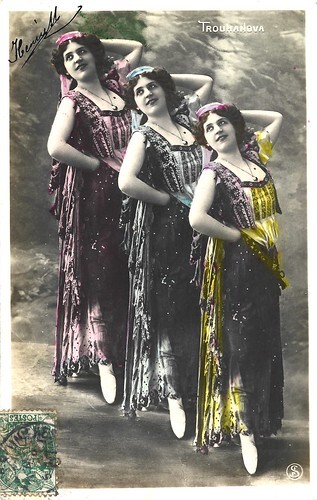
French postcard by Ed. S.I.P., no. 1442 (according to other examples of this card). Photo: Reutlinger, Paris.
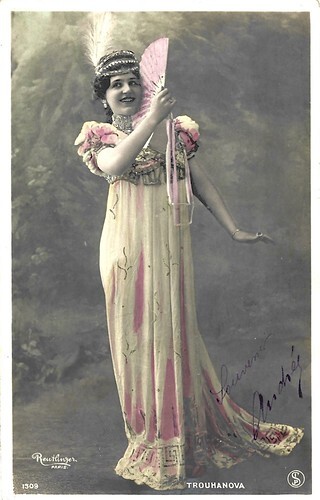
French postcard by Ed. S.I.P., no. 1309. Photo: Reutlinger, Paris.
A well-publicised confrontation with Richard Strauss
Natalia or Natasha Trouhanova was born Natalia Vladimirovna Troukhanova (Наталія Володимирівна Труханова) in 1885, in Kiev, the Russian Empire (now Kyiv, Ukraine). She was the daughter of Vladimir Bostunov, a Russian opera singer and star of the Kyiv operetta, and Marie Brown, a Frenchwoman born in Alsace. After arriving in Moscow with her mother at fifteen and a half, she married Lieutenant B. F. Trukhanov. She escaped from family custody by marrying, and the couple soon divorced.
From 1904, she lived in France, where in no time she became a great master of dance. She worked with and was acquainted with Sergei Diaghilev, Fyodor Chaliapin , Richard Strauss, and Isadora Duncan. Her friends, colleagues, and associates were Maurice Ravel, Max Reinhardt , and Camille Saint-Saëns, to whose music Trouhanova created a choreographic miniature for her 'Dance of Death' that impressed the composer.
Leonida Sobinova noted in one of her letters with surprise: "Trukhanova is full of thoughts about her dances. I did not even expect her to be so serious about it... She has a photograph of Massenet on her desk with a most pleasant inscription. Next season she will dance a new ballet by him here."
Wikipedia (English): "She made international news for wearing extravagant diamonds on stage at Monte Carlo in 1906. She was known for dancing the part of Salome in various Paris productions, including Richard Strauss's 'Salome' (1907, dancing for singer Emmy Destinn), Antoine Mariotte's opera 'Salomé' (1910, dancing for singer Lucienne Bréval), and in Florent Schmitt's 'La tragédie de Salomé' (1912). She also premiered Paul Dukas's 'La Péri' (1911), which he dedicated to her and which she performed in 1912.
She also performed in Maurice Ravel's 'Adelaide, or the Language of Flowers' in 1912, and acted the part of 'the Nun' in Max Reinhardt's 'The Miracle' (1911/ 1912). In 1914, she danced at Rheims for the Sixth Olympic Congress. She had a well-publicised confrontation with Richard Strauss in 1907, when he refused to let her take a curtain call as Salomé, next to the singer of the part, "as he considered the art of dancing was an inferior one"; she left the production and described the insult in a letter to the press."
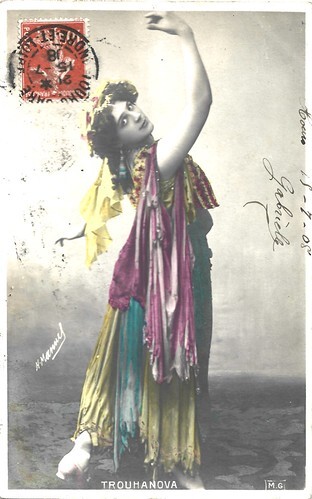
French postcard by Edit. M.G. Photo: H. Manuel.
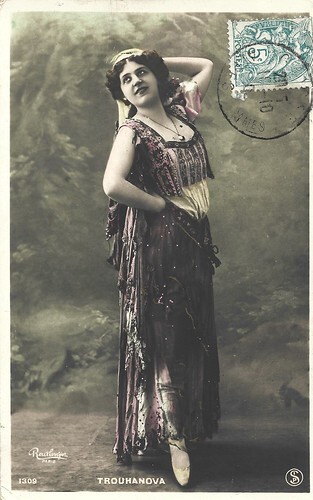
French postcard by Ed. S.I.P., no. 1309. Photo: Reutlinger, Paris.
A memoir full of masculine intelligence and charming femininity
Trouhanova appeared in several French silent films between 1909 and 1916, mostly short films, beginning with the Pathé production La laide, conte hindou / The Ugly Girl (Michel Carré, 1909). Next, at Pathé, she was Maguelonne in Le roi 's amuse / Rigoletto (Michel Carré, Albert Capellani, 1909), opposite Paul Capellani as King François I and Henry Sylvain as Triboulet, and based on Victor Hugo 's novel. IMDb also mentions Rigoletto, but this is the same film.
In 1911 Trouhanova acted at Eclipse in the films Milton (Henri Desfontaines, 1911) and the William Shakespeare adaptation La mégère apprivoisée / The Taming of the Shrew (Henri Desfontaines, 1911). In 1913 she played the character Musidora in the Pathé production Le carabine de la mort (Henri Desfontaines, Paul Garbagni, 1913).
Even if all sources write that actress Musidora took her nom de plume from the 1837 novel 'Fortunio' by Théophile Gautier, it may be no coincidence that soon after Trouhanova's film, Musidora adopted the name. After one more film, L'homme nu / The Naked Man (Henri Desfontaines, 1913), starring Raimu , Trouhanova's film career ended in 1916 with the films Léda (dir. unknown, 1916) and La forêt qui écoute / The Listening Forest (Henri Desfontaines, 1916).
Trouhanova retired from the stage when she married in 1918, but she returned in 1921. From 1918, she was the wife of Alexei Ignatiev, a Russian living in Paris. After the First World War, they ran a small farm. The couple went to the Soviet Union in 1936 or 1937. Trouhanova published her memoirs as 'On Stage and Backstage', which were praised by Soviet academician Yevgeny Tarle as "a charming memoir full of masculine intelligence and charming femininity".
Natalia Trouhanova died in 1956, aged 71 years, in Moscow. There is a box of letters to Trouhanova and a manuscript of her memoirs in the Houghton Library at Harvard University.
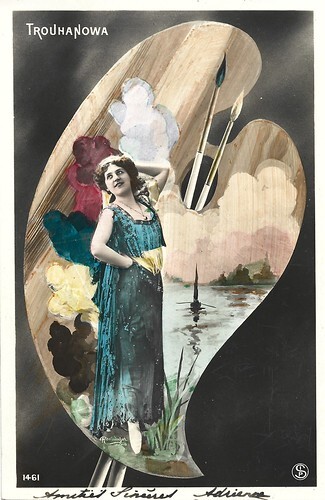
French postcard by Ed. S.I.P., no. 1461.
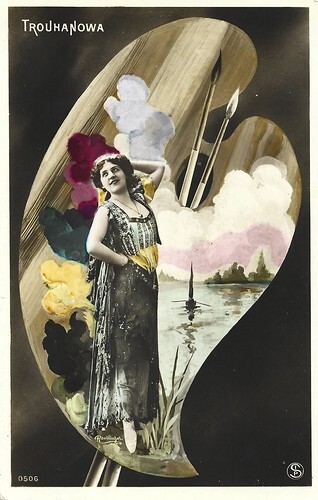
French-German postcard by Ed. S.I.P., no. 1506. This postcard has almost the same illustration as the French postcard above, but it has a different serial number. On the back is an indication that the Neue Photographische Gesellschaft had this card censored in 1906. During the 1900s, Eds. SIP made a whole series with actresses and dancers before the same palette, including e.g. La Toledo and Miéris.
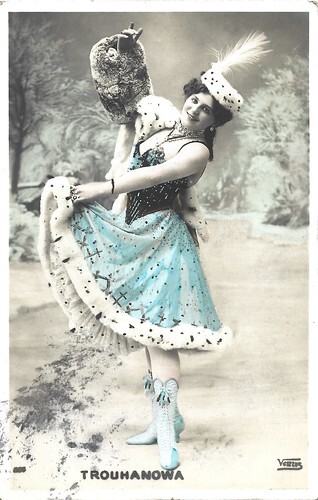
French postcard, number illegible. Photo: Verus.
Sources: Wikipedia (English, French and Ukrainian) and .

French postcard by Ed. S.I.P., no. 1442 (according to other examples of this card). Photo: Reutlinger, Paris.

French postcard by Ed. S.I.P., no. 1309. Photo: Reutlinger, Paris.
A well-publicised confrontation with Richard Strauss
Natalia or Natasha Trouhanova was born Natalia Vladimirovna Troukhanova (Наталія Володимирівна Труханова) in 1885, in Kiev, the Russian Empire (now Kyiv, Ukraine). She was the daughter of Vladimir Bostunov, a Russian opera singer and star of the Kyiv operetta, and Marie Brown, a Frenchwoman born in Alsace. After arriving in Moscow with her mother at fifteen and a half, she married Lieutenant B. F. Trukhanov. She escaped from family custody by marrying, and the couple soon divorced.
From 1904, she lived in France, where in no time she became a great master of dance. She worked with and was acquainted with Sergei Diaghilev, Fyodor Chaliapin , Richard Strauss, and Isadora Duncan. Her friends, colleagues, and associates were Maurice Ravel, Max Reinhardt , and Camille Saint-Saëns, to whose music Trouhanova created a choreographic miniature for her 'Dance of Death' that impressed the composer.
Leonida Sobinova noted in one of her letters with surprise: "Trukhanova is full of thoughts about her dances. I did not even expect her to be so serious about it... She has a photograph of Massenet on her desk with a most pleasant inscription. Next season she will dance a new ballet by him here."
Wikipedia (English): "She made international news for wearing extravagant diamonds on stage at Monte Carlo in 1906. She was known for dancing the part of Salome in various Paris productions, including Richard Strauss's 'Salome' (1907, dancing for singer Emmy Destinn), Antoine Mariotte's opera 'Salomé' (1910, dancing for singer Lucienne Bréval), and in Florent Schmitt's 'La tragédie de Salomé' (1912). She also premiered Paul Dukas's 'La Péri' (1911), which he dedicated to her and which she performed in 1912.
She also performed in Maurice Ravel's 'Adelaide, or the Language of Flowers' in 1912, and acted the part of 'the Nun' in Max Reinhardt's 'The Miracle' (1911/ 1912). In 1914, she danced at Rheims for the Sixth Olympic Congress. She had a well-publicised confrontation with Richard Strauss in 1907, when he refused to let her take a curtain call as Salomé, next to the singer of the part, "as he considered the art of dancing was an inferior one"; she left the production and described the insult in a letter to the press."

French postcard by Edit. M.G. Photo: H. Manuel.

French postcard by Ed. S.I.P., no. 1309. Photo: Reutlinger, Paris.
A memoir full of masculine intelligence and charming femininity
Trouhanova appeared in several French silent films between 1909 and 1916, mostly short films, beginning with the Pathé production La laide, conte hindou / The Ugly Girl (Michel Carré, 1909). Next, at Pathé, she was Maguelonne in Le roi 's amuse / Rigoletto (Michel Carré, Albert Capellani, 1909), opposite Paul Capellani as King François I and Henry Sylvain as Triboulet, and based on Victor Hugo 's novel. IMDb also mentions Rigoletto, but this is the same film.
In 1911 Trouhanova acted at Eclipse in the films Milton (Henri Desfontaines, 1911) and the William Shakespeare adaptation La mégère apprivoisée / The Taming of the Shrew (Henri Desfontaines, 1911). In 1913 she played the character Musidora in the Pathé production Le carabine de la mort (Henri Desfontaines, Paul Garbagni, 1913).
Even if all sources write that actress Musidora took her nom de plume from the 1837 novel 'Fortunio' by Théophile Gautier, it may be no coincidence that soon after Trouhanova's film, Musidora adopted the name. After one more film, L'homme nu / The Naked Man (Henri Desfontaines, 1913), starring Raimu , Trouhanova's film career ended in 1916 with the films Léda (dir. unknown, 1916) and La forêt qui écoute / The Listening Forest (Henri Desfontaines, 1916).
Trouhanova retired from the stage when she married in 1918, but she returned in 1921. From 1918, she was the wife of Alexei Ignatiev, a Russian living in Paris. After the First World War, they ran a small farm. The couple went to the Soviet Union in 1936 or 1937. Trouhanova published her memoirs as 'On Stage and Backstage', which were praised by Soviet academician Yevgeny Tarle as "a charming memoir full of masculine intelligence and charming femininity".
Natalia Trouhanova died in 1956, aged 71 years, in Moscow. There is a box of letters to Trouhanova and a manuscript of her memoirs in the Houghton Library at Harvard University.

French postcard by Ed. S.I.P., no. 1461.

French-German postcard by Ed. S.I.P., no. 1506. This postcard has almost the same illustration as the French postcard above, but it has a different serial number. On the back is an indication that the Neue Photographische Gesellschaft had this card censored in 1906. During the 1900s, Eds. SIP made a whole series with actresses and dancers before the same palette, including e.g. La Toledo and Miéris.

French postcard, number illegible. Photo: Verus.
Sources: Wikipedia (English, French and Ukrainian) and .
Published on August 02, 2025 22:00
August 1, 2025
The Many Faces and Names of Dorothea Thiele
For years, two Italian postcards with the unknown actress Renée Pelar on our Flickr site puzzled us. Who was she? Was she French? Italian? Recently, the mystery was revealed thanks to a collaboration of collectors and researchers from both sides of the Atlantic Ocean. Pelar was a German film actress of the silent era who used several names, but her birth name was Dorothea Thiele (1896-1985).
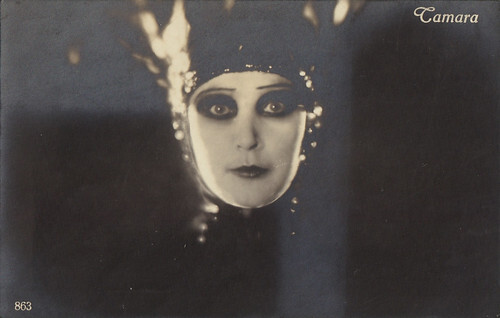
Italian postcard by Ed. A.Traldi, Milano, no. 863. Dorothea Thiele aka Tamara as Oberon in Ein Sommernachtstraum (Hans Neumann, 1925). Collection: Marlene Pilaete.
Solving a mystery
Our research journey began when German film collector Werner Mohr pointed out to Jean Ritsema, the cataloguer at the Ross Image Archive, that the name 'Tamara Karsavina' was attributed incorrectly to a card on the Ross Verlag site . The card was edited by the Italian company Traldi from Milan, number 863, and entitled Tamara. Mohr speculated at that time that the photo on the card was taken from a still from the 1924-1925 film Ein Sommernachtstraum, by Hans Neumann.
Using the terms 'Ein Sommernachtstraum' and 'Tamara', Ritsema came across a 1925 interview in the German journal Filmland , which is available on the website of the Media History Digital Library project. Jean shared a copy with Mohr. When he looked into the films referenced in the interview, Werner saw that an actress named Renée Pelar was connected with the Italian films, which were mentioned in the interview.
As Ritsema didn’t have much luck with additional searches, she reached out to Johan Delbecke in Belgium. Delbecke is known to be very effective at researching online and has helped her with other questions in the past, usually unrelated to his primary collection interest - Cléo de Mérode.
Pairing Pelar with Tamara in a search, Johan quickly found a posting on the German actress Dorothea Thiele on the site Steffi-line.de by Stephanie D’heil. This opened the door to solving the mystery as D’heil had made a connection between Thiele and Pelar, but also two other names: Thea Pellard, the actress mentioned in Filmland as acting in Friedrich Zelnik ’s Eugen Onegin, and the mysterious ‘Tamara’.
As Stephanie D’heil writes, Dorothea Thiele, aka Tamara, aka Renée Pelar, aka Thea Pellard, was a German film actress of the silent era, who lived from 1896 to 1985.
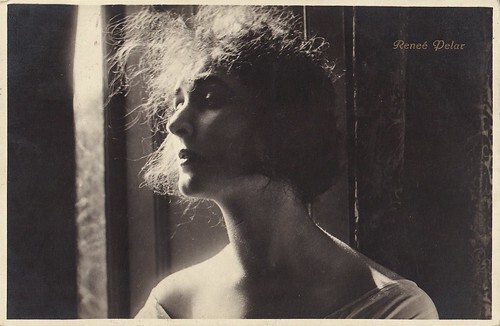
Italian postcard by G.B. Falci, Milano (Milan). Dorothea Thiele aka Renée Pelar. Collection: Marlene Pilaete.
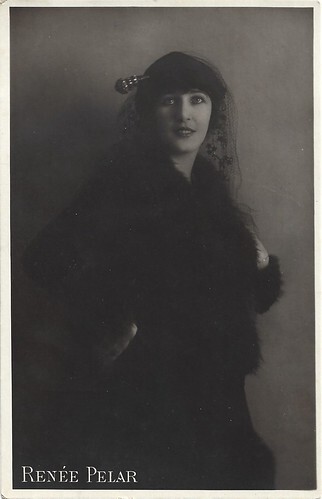
Italian postcard by Fotocelere, Torino (Turin). Dorothea Thiele aka Renée Pelar.
Dorothea Thiele
She was born on 23 March 1896 as Dorothea Elise Alma Gertrud Thiele in Berlin-Wilmersdorf. "Her Polish-born father, Rudolf Thiele, is a well-known painter; he also plays the piano well. (...) The mother is an unusually beautiful, elegant woman. Admired and idolised on all occasions that the parents diligently attended. (...) Dorothea's beauty is in no way inferior to that of her mother. She loves beautiful dresses and marvellous hats. She starts an apprenticeship as a milliner. Then gives it up. She learns shorthand and typing. She had no specific career goal." (This was cited by Stephanie D'heil from Alfred Häsler, Außenseiter-Innenseiter, 28 Porträts aus der Schweiz and translated by us).
On 5 April 1914, Dorothea married the Zürich architect Alwin Spengler in Berlin-Charlottenburg. Their son was born the same year on 19 October 1914, but the baby died just a few days after his birth. Through the court painter Professor Jung, the young woman met the actor and director Friedrich Zelnik. He offered her the part of Tatjana opposite him in the silent film Eugen Onegin (Alfred Halm, 1919), based on the eponymous verse novel by Alexander Pushkin, which Zelnik produced.
Dorothea used the stage name Thea Pellard for the film. From then on, she appeared in various silent productions under different pseudonyms. She acted as Renée Pelar in a series of Italian films, including La donna del mare / The Woman of the Sea (1922), based on a stage play by Henrik Ibsen. As Tamara, she acted in various German films of the 1920s, including Ein Sommernachtstraum / A Summer Night's Dream (Hans Neumann, 1925) and Georg Wilhelm Pabst’s famous film Die freudlose Gasse / Joyless Street (1925).
Probably in the mid-1930s, Thiele married the Swiss painter Peter Voltz (1910-1978) from Zürich. She withdrew with him to Sant'Abbondio in Ticino, southern Switzerland. Later, the couple moved to Locarno. The former film star dedicated herself to painting too, first on glass, later on canvas. She had a few exhibitions of her paintings, which could be described as 'naive art'. According to some sources, she converted to Buddhism. Tamara Voltz passed away in Klosters, Switzerland, on 4 August 1985, at the advanced age of 89.
Yet, IMDb , the website of the San Francisco Silent Film Festival, Filmportal.de , and even Stephanie D’heil identify 'Tamara' as the Russian-American actress and ballet dancer Tamara Geva, which raised new questions. However, Geva’s memoirs and descriptions of her Berlin times make it unlikely that she was involved in the Italian films by Pelar or the German films such as Ein Sommernachtstraum. Ritsema, therefore, contacted Jan-Christopher Horak, who is a noted specialist in German cinema. For information on Renée Pelar, she contacted EFSP collaborator Ivo Blom, who is an expert in Italian silent film. Consulting Häsler’s book cited on Steffi-line.de , Horak found confirmation of Mohr’s earlier assumptions that 'Tamara' alias Thiele acted not only as Oberon in Ein Sommernachtstraum but also as Pelar in various Italian films.
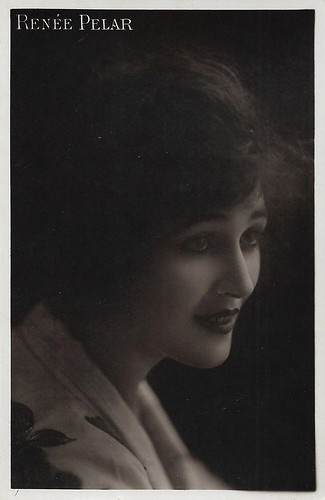
Italian postcard by Fotocelere, Torino.
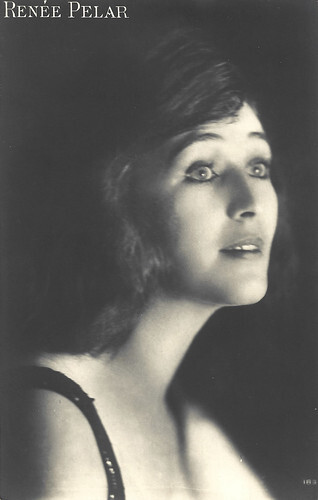
Italian postcard by Fotocelere, Torino, no. 183.
Renée Pelar & Tamara
According to Vittorio Martinelli’s reference books, Il cinema muto italiano, Vols. 1920 and 1921-1922, Dorothea Thiele's first Italian film as Renée Pelar was Liberazione / Liberation (Jacques Creusy, 1920) with Mario Parpagnoli , but it was severely condemned by the Italian press, not for its main performances but for its ridiculous story. Critics saw the liberation rather in the possibility of leaving the cinema.
After this, Renée Pelar acted in Senza amore / Without Love (Arnaldo Fratelli, 1921), with Luciano Molinari and Dolly Morgan, largely shot in Tripoli, but unseen by audiences. Luigi Pirandello supposedly suggested the original title: Pantera di neve. Lastly, Pelar acted in the Ibsen adaptation La donna del mare / The Lady from the Sea (Nino Valentini, 1922). The latter film got praise for its photography, but the Italian press thought Ibsen unfit for Italian cinema.
According to Filmportal.de , as ‘Tamara’, Thiele also acted as Cora, the girlfriend of the villain Rawlinson (Robert Scholz), in all four episodes of the German serial Die Jagd nach dem Tode / The Hunt for Death (Karl Gerhardt, 1921), starring Nils Chrisander and Lil Dagover : Die Jagd nach dem Tode, Der Mann im Dunkel, Die verbotene Stadt and Die Goldmine von Sar-Khin, all produced by Erich Pommer for Decla Film. She also acted in the Hans Land adaptation Das Mädchen aus dem goldenen Westen / The Girl of the Golden West (Hans Werckmeister, 1922), starring Georg Alexander , and (not mentioned by IMDb ) Die Tragödie einer Liebesnacht / The Tragedy of a Night of Love (Franz Osten, 1923), with Dary Holm .
In the 1925 interview in Filmland , Thiele (as ‘Tamara’) described her former film career. The films she mentions are those under the pseudonyms of Thea Pellard and Renée Pelar, plus her role as Oberon under the name of Tamara in Ein Sommernachtstraum. She doesn’t mention the two other German films with Tamara, Die Freudlose Gasse / Joyless Street (G. W. Pabst, 1925) and Gräfin Plättmamsell / Countess Plättmamsell (Constantin J. David, 1926). Possibly, they were produced after the interview was written. So their attribution remains with a question mark, although she probably did them too.
Filmportal also equates 'Tamara' with Tamara Tolstoï, aka Countess Tolstoï, the latter actress in Die freudlose Gasse. Yet, whether Thiele also worked under the pseudonym Tamara Tolstoï remains uncertain and is not likely. After Ivo Blom recently wrote about this research at Flickr, IMDb updated its lemma on Dorothea Thiele, but the database mistakenly included the films of another actress, Erna Thiele. IMDb also has separate lemmas on and .
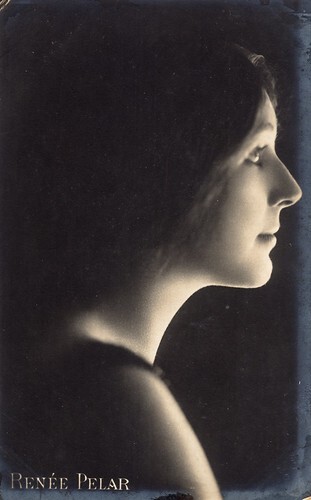
Italian postcard by Fotocelere. Collection: Jean Ritsema.

German postcard by Ross Verlag, Berlin, no. 1239/1, 1927-1928. Dorothea Thiele aka Tamara. Collection: Marlene Pilaete.
We’d like to thank all who contributed to this ‘expedition’. First of all, our thanks to Stephanie D'heil for her remarkable website Steffi-line.de. Then we thank Jean Ritsema, Werner Mohr, Johan Delbecke, and Jan-Christopher Horak for their research. Many thanks also to EFSP collaborators Marlène Pilaete and Ivo Blom for their postcards and Ivo for his research and his notes on the expedition. Sources: Stephanie D'Heil (Steffi-Line - German), Media History Project, Ross Verlag Postcards, Vittorio Martinelli (Il cinema muto italiano Vols. 1920 and 1921-22), Alfred Häsler ('Außenseiter-Innenseiter, 28 Porträts aus der Schweiz', Verlag Huber Frauenfeld, 1983), San Francisco Silent Film Festival, and .

Italian postcard by Ed. A.Traldi, Milano, no. 863. Dorothea Thiele aka Tamara as Oberon in Ein Sommernachtstraum (Hans Neumann, 1925). Collection: Marlene Pilaete.
Solving a mystery
Our research journey began when German film collector Werner Mohr pointed out to Jean Ritsema, the cataloguer at the Ross Image Archive, that the name 'Tamara Karsavina' was attributed incorrectly to a card on the Ross Verlag site . The card was edited by the Italian company Traldi from Milan, number 863, and entitled Tamara. Mohr speculated at that time that the photo on the card was taken from a still from the 1924-1925 film Ein Sommernachtstraum, by Hans Neumann.
Using the terms 'Ein Sommernachtstraum' and 'Tamara', Ritsema came across a 1925 interview in the German journal Filmland , which is available on the website of the Media History Digital Library project. Jean shared a copy with Mohr. When he looked into the films referenced in the interview, Werner saw that an actress named Renée Pelar was connected with the Italian films, which were mentioned in the interview.
As Ritsema didn’t have much luck with additional searches, she reached out to Johan Delbecke in Belgium. Delbecke is known to be very effective at researching online and has helped her with other questions in the past, usually unrelated to his primary collection interest - Cléo de Mérode.
Pairing Pelar with Tamara in a search, Johan quickly found a posting on the German actress Dorothea Thiele on the site Steffi-line.de by Stephanie D’heil. This opened the door to solving the mystery as D’heil had made a connection between Thiele and Pelar, but also two other names: Thea Pellard, the actress mentioned in Filmland as acting in Friedrich Zelnik ’s Eugen Onegin, and the mysterious ‘Tamara’.
As Stephanie D’heil writes, Dorothea Thiele, aka Tamara, aka Renée Pelar, aka Thea Pellard, was a German film actress of the silent era, who lived from 1896 to 1985.

Italian postcard by G.B. Falci, Milano (Milan). Dorothea Thiele aka Renée Pelar. Collection: Marlene Pilaete.

Italian postcard by Fotocelere, Torino (Turin). Dorothea Thiele aka Renée Pelar.
Dorothea Thiele
She was born on 23 March 1896 as Dorothea Elise Alma Gertrud Thiele in Berlin-Wilmersdorf. "Her Polish-born father, Rudolf Thiele, is a well-known painter; he also plays the piano well. (...) The mother is an unusually beautiful, elegant woman. Admired and idolised on all occasions that the parents diligently attended. (...) Dorothea's beauty is in no way inferior to that of her mother. She loves beautiful dresses and marvellous hats. She starts an apprenticeship as a milliner. Then gives it up. She learns shorthand and typing. She had no specific career goal." (This was cited by Stephanie D'heil from Alfred Häsler, Außenseiter-Innenseiter, 28 Porträts aus der Schweiz and translated by us).
On 5 April 1914, Dorothea married the Zürich architect Alwin Spengler in Berlin-Charlottenburg. Their son was born the same year on 19 October 1914, but the baby died just a few days after his birth. Through the court painter Professor Jung, the young woman met the actor and director Friedrich Zelnik. He offered her the part of Tatjana opposite him in the silent film Eugen Onegin (Alfred Halm, 1919), based on the eponymous verse novel by Alexander Pushkin, which Zelnik produced.
Dorothea used the stage name Thea Pellard for the film. From then on, she appeared in various silent productions under different pseudonyms. She acted as Renée Pelar in a series of Italian films, including La donna del mare / The Woman of the Sea (1922), based on a stage play by Henrik Ibsen. As Tamara, she acted in various German films of the 1920s, including Ein Sommernachtstraum / A Summer Night's Dream (Hans Neumann, 1925) and Georg Wilhelm Pabst’s famous film Die freudlose Gasse / Joyless Street (1925).
Probably in the mid-1930s, Thiele married the Swiss painter Peter Voltz (1910-1978) from Zürich. She withdrew with him to Sant'Abbondio in Ticino, southern Switzerland. Later, the couple moved to Locarno. The former film star dedicated herself to painting too, first on glass, later on canvas. She had a few exhibitions of her paintings, which could be described as 'naive art'. According to some sources, she converted to Buddhism. Tamara Voltz passed away in Klosters, Switzerland, on 4 August 1985, at the advanced age of 89.
Yet, IMDb , the website of the San Francisco Silent Film Festival, Filmportal.de , and even Stephanie D’heil identify 'Tamara' as the Russian-American actress and ballet dancer Tamara Geva, which raised new questions. However, Geva’s memoirs and descriptions of her Berlin times make it unlikely that she was involved in the Italian films by Pelar or the German films such as Ein Sommernachtstraum. Ritsema, therefore, contacted Jan-Christopher Horak, who is a noted specialist in German cinema. For information on Renée Pelar, she contacted EFSP collaborator Ivo Blom, who is an expert in Italian silent film. Consulting Häsler’s book cited on Steffi-line.de , Horak found confirmation of Mohr’s earlier assumptions that 'Tamara' alias Thiele acted not only as Oberon in Ein Sommernachtstraum but also as Pelar in various Italian films.

Italian postcard by Fotocelere, Torino.

Italian postcard by Fotocelere, Torino, no. 183.
Renée Pelar & Tamara
According to Vittorio Martinelli’s reference books, Il cinema muto italiano, Vols. 1920 and 1921-1922, Dorothea Thiele's first Italian film as Renée Pelar was Liberazione / Liberation (Jacques Creusy, 1920) with Mario Parpagnoli , but it was severely condemned by the Italian press, not for its main performances but for its ridiculous story. Critics saw the liberation rather in the possibility of leaving the cinema.
After this, Renée Pelar acted in Senza amore / Without Love (Arnaldo Fratelli, 1921), with Luciano Molinari and Dolly Morgan, largely shot in Tripoli, but unseen by audiences. Luigi Pirandello supposedly suggested the original title: Pantera di neve. Lastly, Pelar acted in the Ibsen adaptation La donna del mare / The Lady from the Sea (Nino Valentini, 1922). The latter film got praise for its photography, but the Italian press thought Ibsen unfit for Italian cinema.
According to Filmportal.de , as ‘Tamara’, Thiele also acted as Cora, the girlfriend of the villain Rawlinson (Robert Scholz), in all four episodes of the German serial Die Jagd nach dem Tode / The Hunt for Death (Karl Gerhardt, 1921), starring Nils Chrisander and Lil Dagover : Die Jagd nach dem Tode, Der Mann im Dunkel, Die verbotene Stadt and Die Goldmine von Sar-Khin, all produced by Erich Pommer for Decla Film. She also acted in the Hans Land adaptation Das Mädchen aus dem goldenen Westen / The Girl of the Golden West (Hans Werckmeister, 1922), starring Georg Alexander , and (not mentioned by IMDb ) Die Tragödie einer Liebesnacht / The Tragedy of a Night of Love (Franz Osten, 1923), with Dary Holm .
In the 1925 interview in Filmland , Thiele (as ‘Tamara’) described her former film career. The films she mentions are those under the pseudonyms of Thea Pellard and Renée Pelar, plus her role as Oberon under the name of Tamara in Ein Sommernachtstraum. She doesn’t mention the two other German films with Tamara, Die Freudlose Gasse / Joyless Street (G. W. Pabst, 1925) and Gräfin Plättmamsell / Countess Plättmamsell (Constantin J. David, 1926). Possibly, they were produced after the interview was written. So their attribution remains with a question mark, although she probably did them too.
Filmportal also equates 'Tamara' with Tamara Tolstoï, aka Countess Tolstoï, the latter actress in Die freudlose Gasse. Yet, whether Thiele also worked under the pseudonym Tamara Tolstoï remains uncertain and is not likely. After Ivo Blom recently wrote about this research at Flickr, IMDb updated its lemma on Dorothea Thiele, but the database mistakenly included the films of another actress, Erna Thiele. IMDb also has separate lemmas on and .

Italian postcard by Fotocelere. Collection: Jean Ritsema.

German postcard by Ross Verlag, Berlin, no. 1239/1, 1927-1928. Dorothea Thiele aka Tamara. Collection: Marlene Pilaete.
We’d like to thank all who contributed to this ‘expedition’. First of all, our thanks to Stephanie D'heil for her remarkable website Steffi-line.de. Then we thank Jean Ritsema, Werner Mohr, Johan Delbecke, and Jan-Christopher Horak for their research. Many thanks also to EFSP collaborators Marlène Pilaete and Ivo Blom for their postcards and Ivo for his research and his notes on the expedition. Sources: Stephanie D'Heil (Steffi-Line - German), Media History Project, Ross Verlag Postcards, Vittorio Martinelli (Il cinema muto italiano Vols. 1920 and 1921-22), Alfred Häsler ('Außenseiter-Innenseiter, 28 Porträts aus der Schweiz', Verlag Huber Frauenfeld, 1983), San Francisco Silent Film Festival, and .
Published on August 01, 2025 22:00
Paul van Yperen's Blog
- Paul van Yperen's profile
- 13 followers
Paul van Yperen isn't a Goodreads Author
(yet),
but they
do have a blog,
so here are some recent posts imported from
their feed.



